#like it activates the rage instinct in so many viewers
Explore tagged Tumblr posts
Text
Jayce’s existence in Arcane really explores the horror of what it would be like to be a completely dweeby nerd with the face and figure of a football player
#Jayce talis#arcane#like it activates the rage instinct in so many viewers#people hate him legitimately because of his muscles and face#poor guy just wants to do science#even IN UNIVERSE people think he’s dumb based on his looks#is he wise no but boy definitely has a PhD in magical engineering#he just happens to look like body builder Prince Charming and it’s NOT HIS FAULT#but god that beard did him so favors huh#he should have grown one sooner#I bet Viktor goes feral over that beard
147 notes
·
View notes
Note
As a casual nat stan, i feel a little bit weirded out the amount of genuine smiling throughout the snippets i've seen--to the point where i thought it was uncharacteristic. Not that i think nat is incapable of basic human emotions, but i guess i'm used to her being so stoic? Weirdly, her stoicness is what drawn me to her bcs i too am a very guarded person. How do you think the film portray her in this department?
I have been sitting on this one since before the movie came out because I couldn't figure out how to answer it in a way that wasn't spoilery.
Let's gooooo.
I am ALSO seriously into Nat's guardedness. I think that media very rarely knows what to do with women who aren't either great at emotions or complete robots, and in past movies Natasha has given us just enough to show that she's neither. And Nat's reliance on performativity, in particular, has always worked for me; I grew up with the belief that you have to behave in certain ways for people to accept you, and seeing characters get emotional with very little provocation makes me actively uncomfortable as a viewer, like I'm seeing something private I shouldn't.
Nat's emotions in this movie worked for me for a few reasons.
One is one of my favorite details of the movie: Natasha (and Melina) were psychologically conditioned, while Yelena (and the other Widows in her cohort) were brainwashed. The conditioning required the Widows to be extremely carefully controlled, because of the negative consequences if they didn't. The brainwashing removed the ability to control, because it was never their choice. So we see that in Morocco Yelena is extremely controlled, and then right after that we see her expressing emotions far more freely than we ever see from Nat (even ten-year-old Nat) or Melina. She doesn't have the instincts to not.
Another is that in most of the scenes where we see Natasha showing strong emotions, positive or negative, it's with people she was only close with from ages seven or eight to ten or eleven. There's an element of Nat unintentionally regressing and needing to consciously regain her Adult In Control Of The Situation approach, repeatedly; we see it most clearly in the "don't slouch" scene but for me her first scenes with Yelena are that much more telling. She's metaphorically an adult staying in her childhood bedroom at her parents' house and trying to figure out why the bed doesn't feel like she remembers.
A third is one that I didn't actually realize until thinking more about this movie: yes, Natasha is smiling sincerely more here. But she's also angry more. It wasn't until I had seen this movie a few times that I started to think of all the times I've identified Nat as angry in other movies. I still think she HAS been angry, but she's grit her teeth and she's smiled a very tight smile and she has done everything in her power to defuse the situation. (I can't help but think of how Carol's anger got so many fanboys to be like "Why doesn't she smile more?" while Natasha's anger has passed by them entirely unnoticed.) Her smiling, to me, is connected to her ability to express her rage: to try to drown Yelena before offering a truce and drinking together; to yell at Alexei rather than coquettishly convince him to find the Red Room; to call Melina a coward to her face.
Compare it to her conversation with Ross; her tone never wavers. When she has her first conversations with Mason, even though he can tell she's run-down, she's presenting Public-Facing Natasha, who just wants to Get Shit Done. When she thinks Taskmaster is sent by Ross, her ONLY emotional reaction is to say that she's a better shot when she's pissed off. It's only once the Red Room is brought in, and her history is part of things, that her emotions show more on her face.
I don't think Natasha lost all her levels of guardedness in this movie- I think comparing her to Alexei and Yelena is proof of that, as is, frankly, the number of critics who didn't seem to understand what I saw as an extremely clear emotional arc- but I think this movie is a lot closer to the nerve, and as a result we're seeing more get through her mask than we usually would. If that were only positive emotions, I don't think it would work for me. But the film's active choice to give Natasha greater capacity to show her anger made her visible happiness feel more earned, and both parts together made Nat feel like a more complete person to me.
#allofthereplies#Anonymous#Black Widow movie spoilers#BW spoilers#Natasha Romanoff#smiling#anger#psychological conditioning#brainwashing
115 notes
·
View notes
Text
I don’t need you to respect me, I respect me
I’m gonna miss writing about Amethyst.
As the most sisterly Crystal Gem, a firebrand in the new role of middle child after spending millennia as the baby of the group, Amethyst’s story is about growing from a wild teen to a responsible adult. Like Steven, she feels the need to prove that she’s a Crystal Gem too, but unlike Steven, she already is a Crystal Gem, so she carries a different kind of resentment as she continues to be treated like a child. It’s made even worse by her warrior instincts clashing with her small frame: she lives with the constant anxiety that she’s a mistake, a Gem who came out wrong and doesn’t belong in her family, so she comforts and distracts herself with hedonism and shapeshifting. Her problem goes beyond not feeling respected: deep down, she fears that she doesn’t deserve respect.
But she changes her mind.
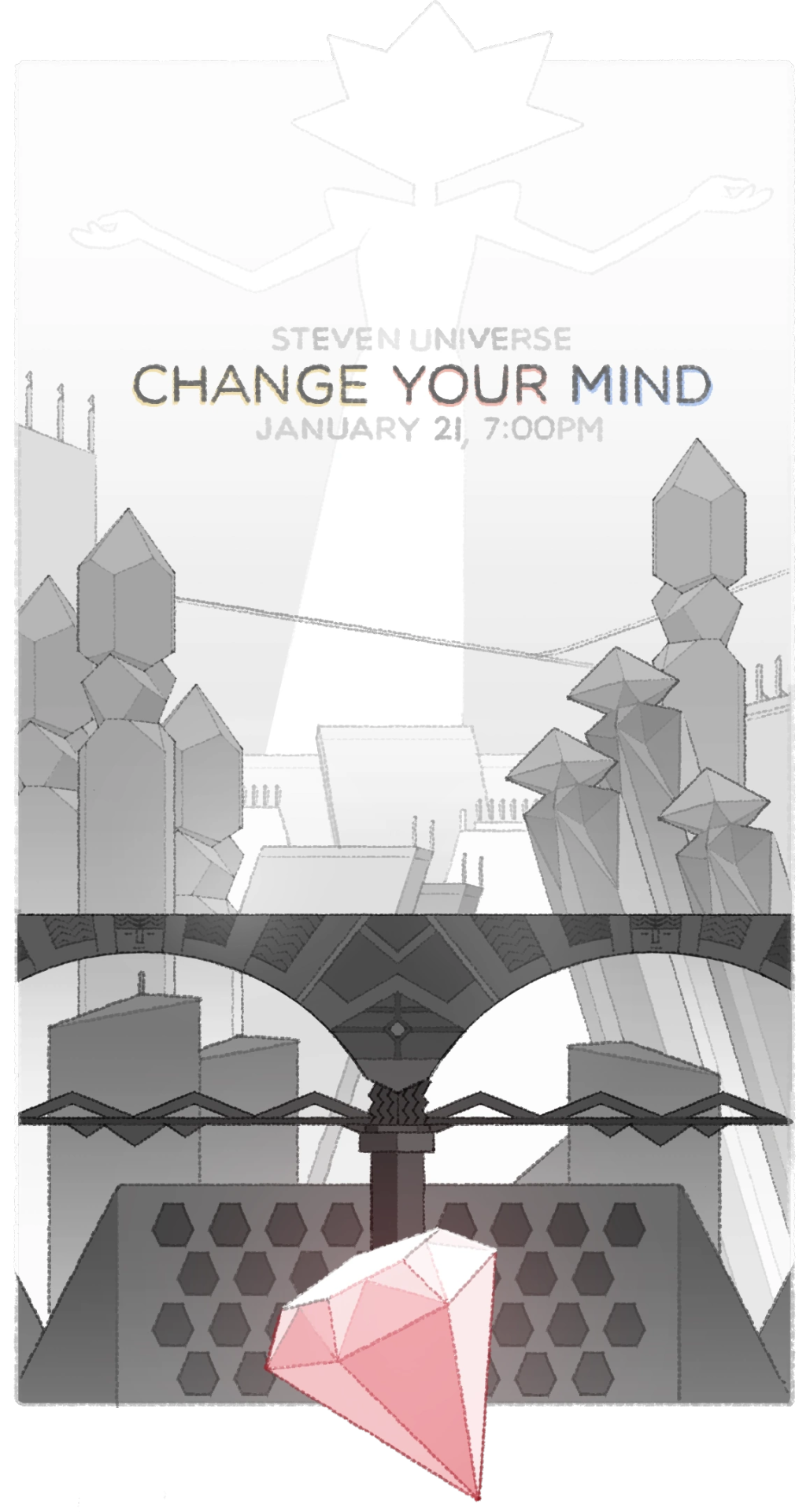
“This isn’t normal.”
The Return and Jailbreak culminated the first act of Steven Universe, giving our characters subtle achievements (Amethyst and Pearl casually fuse into Opal, Greg reveals a deeper understanding of the Gems than we once thought, Beach City comes together as a community when Steven is in danger) and huge changes (Steven summons a massive shield, Garnet’s status as a fusion is confirmed, Lapis goes from prisoner to imprisoner). While not an official finale, Beta and Earthlings culminated the second act, narrowing the focus to five characters as they each reach one milestone or another: Lapis and Amethyst find a level of peace, Peridot defends her new home, Jasper succumbs to corruption, and Steven helps his friends but fails to help his enemy.
In a way, Change Your Mind culminates the third act with an even narrower focus. Sure, it gives big moments to a ton of characters (there’s fanservice galore, and we see the three Diamonds in particular take enormous steps), but we zero in on Steven in the same way the entire act has zeroed in on Steven, because this is a story about identity. It isn’t only about who he is, but who he wants to be moving forward, and fusing all the insights he’s learned from his human family, his Crystal Gem family, and his Diamond family into a song that encapsulates his growth over the course of the series.
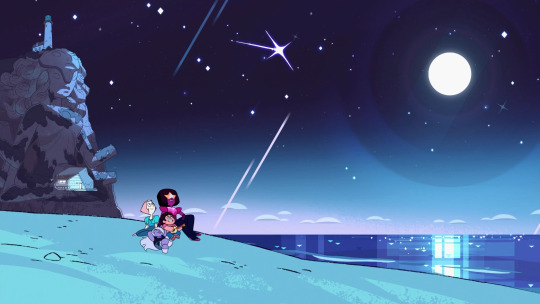
We start in the most lifelike of the Diamond dreams, so real that Steven still sees himself as Steven rather than embodying Pink. Once again, this connection emerges from sleeping in a location where Pink once dwelled, but while he wasn’t feeling her impatience and rage in Jungle Moon, nor her hardening resolve in Can’t Go Back, nor her whimsy in Familiar, this time they share the same headspace when they’re both locked in a tower.
Considering how bombastic things get in this episode, I love how low-key this final dream remains until White Diamond interferes. We’re as lost as Steven at first, worrying about Connie and baffled at Blue’s recognizable mood but incongruous accusations, but as the truth becomes clear, he transforms into Pink off-screen without any fanfare, both in body and in mind: Steven isn’t questioning Blue’s warning about Pink Pearl, Pink Diamond is apologizing for her own behavior in Zach Callison’s voice. Still, looking down jolts him out of it, and after seeing the Crystal Gems poofed at the ball for a more definitive Steven memory, we cycle in Rose’s horror at her family launching a final attack on Earth. The rapid-fire identity shifts that follow inspired the most haunting piece of promo art for the episode, drawn by Rebecca Sugar herself, but I didn’t wanna display it without a seizure warning.
It’s excellent exposition, hitting the highlights of the Diamonds’ many wrongs and establishing Steven’s fraying sense of self in a way that’s both artful and brief; it’s important to remind younger viewers about the stakes, but Change Your Mind doesn’t pretend that anyone should be watching this episode without context, so it doesn’t prioritize thorough explanation. And despite how frightening the nightmare becomes, Steven gains a new sense of clarity after seeing the pattern laid out in front of him. The Diamonds are hurting him in the same way they hurt his mother, and if he’s going to help everyone, he needs to help himself.
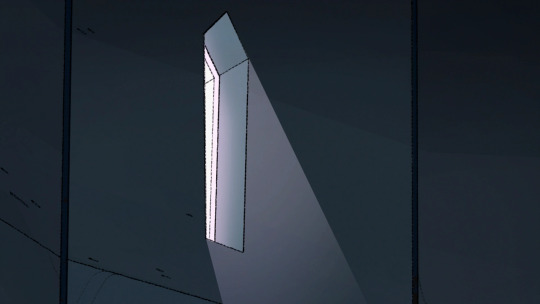
When Blue Diamond returns to the tower in modern day, Steven isn’t afraid, and he isn’t alone. The first of many puns riddling the finale emerges (“Déjà Blue!”) before Connie proves why she’s the perfect partner for our hero, platonic or otherwise. He’s terrible at confronting the people that hurt him—this would require him to acknowledge he’s hurt in the first place, which he’s also terrible at—but if she was comfortable enough with confrontation to call out her best friend when he wrongs her, Blue Diamond doesn’t stand a chance. Connie comes out swinging, loading the bases with candor and sass despite Blue’s confusion over why a human even gets an opinion about this stuff, which makes Steven’s refusal to apologize hit the Diamond like a grand slam.
I love that Steven’s flat “no” takes Connie by surprise as well as Blue, because yeah, it’s uncharacteristically blunt for someone who’s spent his entire trip to Homeworld bending over backwards like he usually does to accommodate others. When he doubles down by explaining that he isn’t sorry about creating a show that celebrates queer characters whoops sorry I mean fusion, Callison makes it sound like the most obvious thing in the world, and this is what upsets Blue enough to inflict her tears on him. We’ll learn even more about Pink’s temper in Steven Universe Future, but the simple act of not bowing to authority makes Steven “worse than ever” in Blue’s mind: violence is more acceptable than insubordination. (Also, violence in cartoons is more acceptable than queer folks just sorta existing in cartoons, but that’s neither here nor there.)
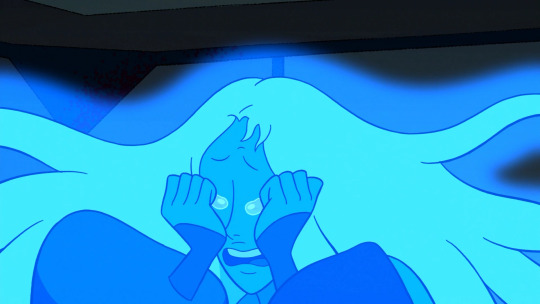
Change Your Mind is about combating bigotry and cycles of abuse, and Blue is the obvious first test. She’s a bigot who doesn’t think she’s a bigot (compared to Yellow, who doesn’t care that she’s a bigot, and White, who’s quite proud of being a bigot). She passively perpetuates a toxic status quo (compared to Yellow, who actively perpetuates it, and White, who established it in the first place). It makes sense that she’s the first of the remaining Diamonds to change her mind, because all it takes for her to realize that something is wrong is thinking about it a little harder.
This doesn’t let her off the hook, of course: Blue’s sloth—the sin, not the animal—might not look flashy next to Yellow’s wrath or White’s pride or Pink’s envy, but she still chose to do nothing for thousands of years rather than contemplate how her actions and her society might have wronged Pink. If it was this easy for Blue to realize she was hurting Pink, it makes it that much more of an issue that it took her this long to figure it out. Unintentional bigots might be the “best” option by default, but they can be just as harmful as intentional bigots, and there’s a special sort of damage that can come from an oppressor who truly believes themselves an ally.
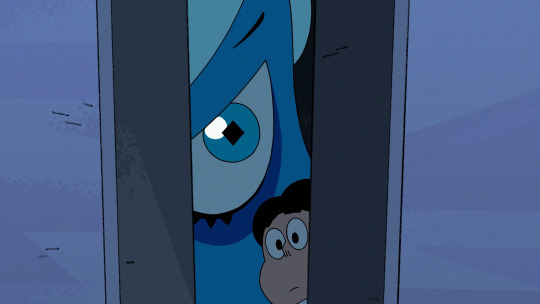
That said, while it’s important to acknowledge her blame (emphasized here when she only stops attacking Steven when he calls her out rather than the Diamonds in general), Blue is also a victim. She’s one of the most powerful beings on Homeworld, but she’s still trapped by White Diamond, and resorts to putting others down as a means of reclaiming a sense of that power. In the same way oppressed people often turn to sexism and racism and homophobia to make themselves feel bigger, Blue (and Yellow) reinforce White’s sweeping bigotry in the same way they echo her family-specific abuse. It’s not a good coping mechanism, in this show or in the real world, but understanding the problem is key to fixing it.
So it still feels like a victory when Blue turns, even though it should’ve happened ages ago, and even though she’s a tyrant. She isn’t just deciding to help Steven, she’s breaking out of that cycle in a way that allows for growth beyond our hero’s immediate concerns. Lisa Hannigan captures this transformation beautifully, shifting from manipulative whining about Pink’s behavior to a crushing realization that she’s the one who’s wrong. And even as she joins Steven’s side, she remains weighed down by her longstanding prejudice: Hannigan stutters as she refers to the Crystal Gems as his family, and her triumphant defense of Steven’s name to Yellow comes with the caveat that she’s still misgendering him.
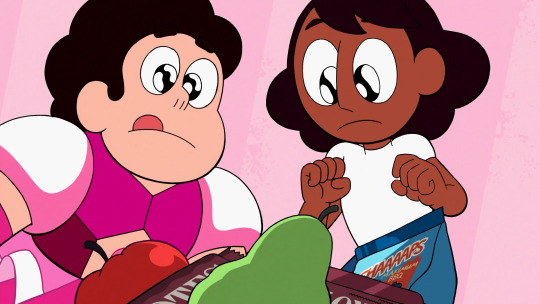
But before we get to Yellow, we take a pit stop that grounds us back to Steven and Connie’s hunger. It may seem small, but this is a critical moment in establishing Steven’s humanity in a way the show has quietly done from day one: with food.
The very first scene of Steven Universe establishes our hero’s human half in a donut shop, upset about dessert. From there, the next five episodes drill in that Steven will take a unique approach to his magical Gem heritage, and they all involve food in a major way: Cookie Cats, then his father’s saying about pork chops and hot dogs, then the Cheeseburger Backpack (important enough to be the episode’s name), then the Together Breakfast (ditto), then creating a monster based on fries.
It’s not just Steven, either. The first few Connie episodes involve eating and drinking in ways that show hints of growth (worrying about trans fats, then sneaking food into movie theaters) and mark key moments in her life (sharing a juicebox, taking her parents to dinner). Lars’s development is tied with his love of baking, and on top of him and Sadie working at the Big Donut, the Frymans and the Pizzas are so tied to their food service jobs that it’s in their names. And speaking of names, we’ve got Vidalia calling her sons Sour Cream and Onion. It even extends to the Gems: Amethyst’s connection with Earth means she loves food, and Pearl’s greater distance from humanity means she can’t stomach it.
Food is fundamentally something that humans require and Gems don’t, and just like we saw in Lars’s Head, Steven’s physical body forces him to think about his own needs despite his usual focus on others. Both his humanity and his ability to stand up for himself are key to his eventual victory, and what could’ve been a generic transition between Blue and Yellow’s big scenes instead becomes a quiet Steven scene. Steven changing into his usual clothes (including his mom’s star) and Connie changing into her own outfit (including her dad’s jacket) is the perfect finishing touch before we dive back into the drama.
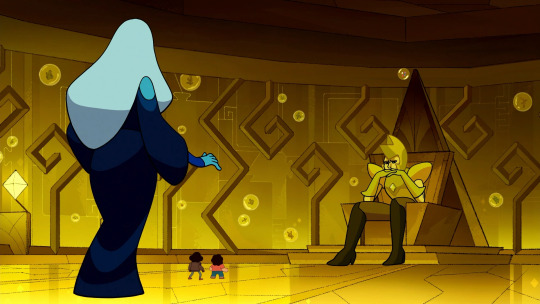
True to their natures, Yellow Diamond gets a starker introduction than Blue’s dream sequence: as the lights burst on, we get two shots focusing on a horrifying number of mutated Gem Shards floating around in the room, then the Crystal Gems’ thankfully intact gems in one big bubble, before panning down to the villain who caused all this pain. The menace is palpable before she even opens her mouth, but Patti LuPone’s low tone keeps the mood from boiling over just long enough that when she loses her cool, it hits like a freight train.
Blue’s passive bigotry endured because she lacked introspection, but Yellow’s active bigotry requires constantly justifying actions she knows are cruel by presenting it as a matter of superior reasoning. We’ve known from her first appearance that Yellow’s seething fury undermines her reputation for cold logic, and now more than ever the connection between her behavior and that of “sophisticated” bigots is clear. You know the type: openly, smugly hateful, but couching their hate as something derived from some deep knowledge about the subject, whether in religious convictions or whatever “science” they can scrape together to confirm their worldview.
Sure enough, even in her rage, Yellow lays down what she sees as a rational explanation for why it was okay to mistreat Pink, and why it’s okay that they themselves are mistreated: if they make exceptions for anyone, even other Diamonds, they must make exceptions for everyone, and chaos reigns. Besides the slippery slope being a fallacy, her argument is punctured by Connie’s second big retort of the night, pointing out that this extreme conclusion of Homeworld Gems living free actually sounds pretty nice. But you can’t force this type of bigot to change their mind through reason; if such a person was actually interested in logical worldviews, they wouldn’t have become a bigot in the first place. You need to change their heart.
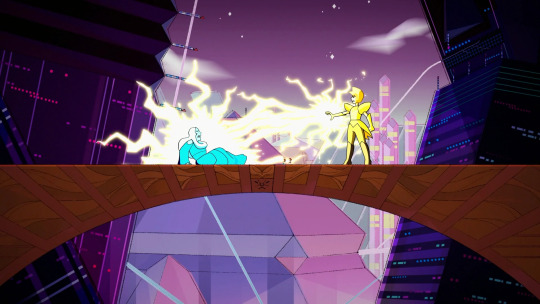
Fortunately, emotions are Blue’s domain, so she’s just the person to help. Unfortunately, in the same way she still can’t get Steven’s pronouns right, Blue lacks experience with healthy communication, and strikes a first blow against Yellow on instinct. The ensuing brawl is brutal, switching between the massive scale of two warring titans and the smaller scale of Steven and Connie scrambling to save the Crystal Gems as Blue and Yellow unload millennia of baggage on each other. It’s so important that Blue is the physical instigator here, as it fuels Yellow’s white-hot self-righteous streak like nothing else, and it keeps the fight from being one-sided all the way through: Yellow pretty much needs to be the one dealing the final blow for the scene to stick, so it gets balanced out by Blue’s opening punch.
Blue uses her powers on Yellow, and Yellow uses her powers on Blue, but Steven’s power is talking. So just like with Blue’s conversion, Connie gets the opening words while Steven gets the finisher. When he finally gets her attention after being ignored throughout the scene, he makes Yellow listen to him by using the same food-based expression I mentioned from all the way back in Laser Light Cannon. It’d pack a bigger punch if Greg said “If every pork chop were perfect, we wouldn’t have hot dogs” at literally any other point in the show, but it still does the trick.
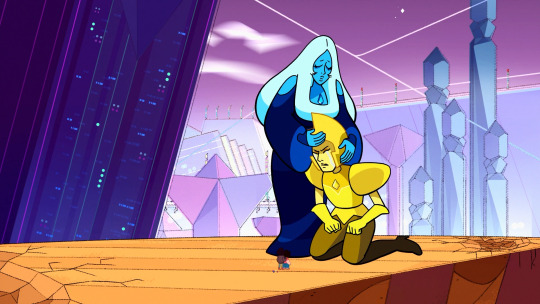
Blue was emotionally ready to accept that Pink was suffering, but hadn’t considered the Diamonds’ role in that suffering. Yellow knew that Pink suffered thanks to the Diamonds, but suppressed her emotions to the point where she couldn’t empathize with her sister’s plight. Blue needed to be more thoughtful to change, and Yellow needed to be more in touch with her emotions to change, and thus the stage is set for the Battle of Heart and Mind against White Diamond.
Except that this isn’t the lesson of Change Your Mind. Blue and Yellow show that some bigots can be reached, which is great! But despite their differences, Steven uses the same basic strategy in both: he doesn’t let them belittle his identity, he confidently dispels their wrongheaded assumptions, and he gets help from allies instead of shouldering the burden himself. We spend the beginning of the episode seeing that in the right circumstances this approach can work, but from here we’ll see that with some bigots, it’s a non-starter.
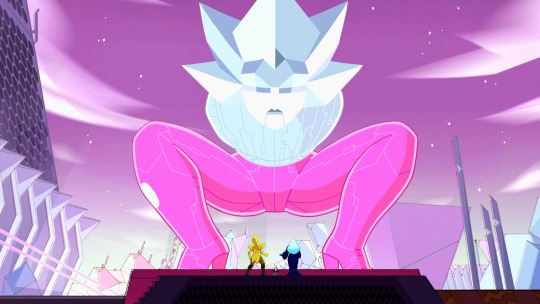
So long as you can engage with bigots while maintaining your self-respect, it can be good work to try and help them see the light. It’s not an obligation, but if you want to change hearts and minds, Steven provides a good template for how to do it. Now the rest of the episode can focus on the bigger lesson: if someone refuses to respect your humanity when you’re steadfast and forthright, it isn’t your job to breathe in their poison, or to hold your breath until you asphyxiate waiting for change.
But more on that after the break!
I Can’t Believe We’ve Come So Far
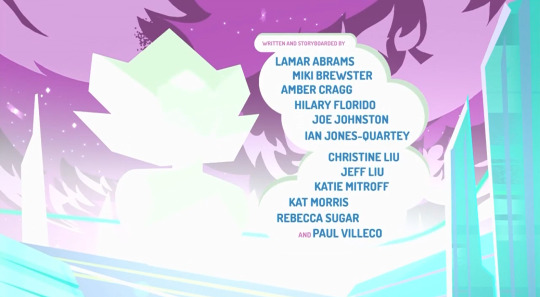
As we reach the end of the original series, it would be criminal not to acknowledge three long-time storyboarders who are on their way out. This isn’t their final contribution to the series, as only one of Change Your Mind’s twelve credited writer/boarders didn’t go on to work on The Movie in some way (Christine Liu, whose tenure was brief but great), and Hilary Florido stayed on as a supervisor for Future. But I wanted to write the big sendoffs here, as this is the last proper “episode” that these three worked on as regular boarders. So it’s time to say goodbye to Katie Mitroff, Hilary Florido, and Jeff Liu.
First up is Katie Mitroff, who clocked two early knockouts with Alone Together and The Test alongside Florido. Mitroff’n’Florido went on to make other classics like Maximum Capacity and Joy Ride before the former teamed up with Lamar Abrams and the latter teamed up with Jesse Zuke for their next batch of episodes.
With Abrams, Mitroff deepened the lore of the show with We Need to Talk, Steven’s Birthday, Bismuth, Buddy’s Book, Three Gems and a Baby, and especially The Answer. She gave us the harrowing revelation of Back to the Moon, and the most ridiculous episode of the series, Restaurant Wars. Her final partner was Paul Villeco, finishing strong with The Trial, Back to the Kindergarten, Your Mother and Mine, Pool Hopping, What’s Your Problem?, Reunited, and Change Your Mind, 100% of which are either in my Love ‘em ranking or my Top Episodes. (Oh, sorry, spoiler alert I love Change Your Mind.)
It’s strange, because she didn’t work on any of the major episodes of Amethyst’s big arc at the end of Season 3, but Mitroff is one of my favorite Amethyst boarders: she’s the consistent thread between Maximum Capacity, Back to the Moon, and What’s Your Problem?, three cornerstones of the character. She excelled at going outside the show’s usual style, as seen in The Answer and Your Mother and Mine, and it’s no coincidence she helped animate Isn’t It Love? to bring Cotton Candy Garnet back for one last ride.
Katie Mitroff is an absolute rock star, I wish her well and you should too.
190 notes
·
View notes
Photo
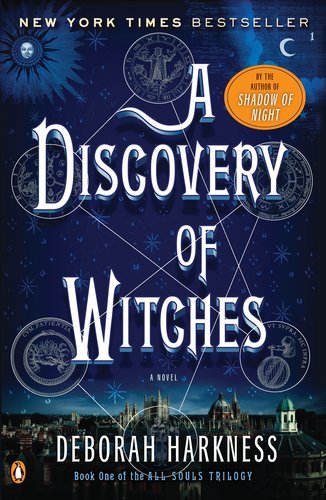

A Discovery of Witches - Show vs Book - 1
If you don’t want to read this long rambling mess of thoughts, I’d say that, in summary, the show and book are great complements for each other. As usual, I would say that it’s best to read the books first and get all the plot through Diana’s POV, as well as more of her inner thoughts. Then, follow up with watching the show to see the other supporting characters more fleshed out, as well as, in general, be able to get solid visualizations of the places, people and magic in the story.
Goes without saying that under the cut there are spoilers for the whole of ADOW S1, as well as mild spoilers for Book 2 and 3, especially at the end where I speculate about Season 2 =w= (( for more ADOW and bishmont feels, my fandom trash site is @cherchersketch. Once S2 is out, I’ll probably throw my episodic book vs show ramblings there ))
Opening
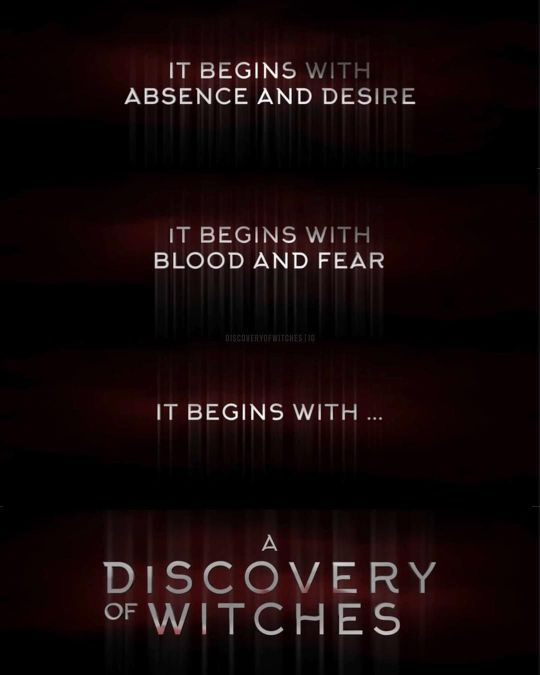
In lieu of some sort of opening song, every episode starts with these words, as well as Matthew’s voiceover, ending with him reciting a phrase that his father once said, “In every ending, there is a new beginning”. It’s interesting because in the book, the titular phrase “ A Discovery of Witches” only appears towards the end as Diana is trying to find out more about Ashmole 782. The mention of Phillipe’s words don’t even show up until near the very end of the second book, Shadow of Night. It is an intriguing way to get viewers interested in the show though. From the very first episode, it’s speculated that Ashmole 782 contains the origins of all 3 types of creatures, vampires, daemons, and witches. It is also reminiscent of Matthew’s speech in episode 2 that only two emotions keep the world turning, desire and fear. The title cards confirm that that is true, Ashmole 782 does, at the very least, contains the origin of witches and their first spells. Especially since, in the actual scene where, in the book, Diana sees those words scrawled on a piece of paper, together with one of the missing Ashmole 782 pages as well as a letter from her parents. Instead of the letter and this phrase, the show uses the house as the expository catalyst instead. In episode 8, Diana only receives the missing page. The house shows, through some sort of flashbacks, more or less what the letter states. It’s one of the many ways the show writers really did a great job changing details so the exposition can be shown, instead of just told outright.
Opening Scene

Honestly, when I first read the book, I was surprised how different the very beginning is. As usual, the main point for switching things around is to be able to organically show and gradually introduce viewers to the world of the series. From Matthew’s opening dialogue, which is the very first shot we see as well as the first dialogue we hear for this and every episode, “Once the world was full of wonders but it belongs to humans now. We creatures have all but disappeared. Daemons, vampires and witches hiding in plain sight, fearful of discovery, ill at ease even with each other.” it immediately lets us know how this world is different from ours, the existence of these three types of supernatural creatures, as well as their hostile attitude towards each other.
It also shows us Diana not having complete control of her powers, accidentally activating them in public. And most importantly, establishes the magic of the book, Ashmole 782. I love the shot of the librarian not finding it initially, then suddenly seeing it in the empty spot as she’s walking back with the rest of Diana’s requested books. In the actual book, it directly opens with Diana having Ashmole 782 in front of her, a brief description of it, and then a bunch of exposition about herself, her parents and her powers.
Bishmont
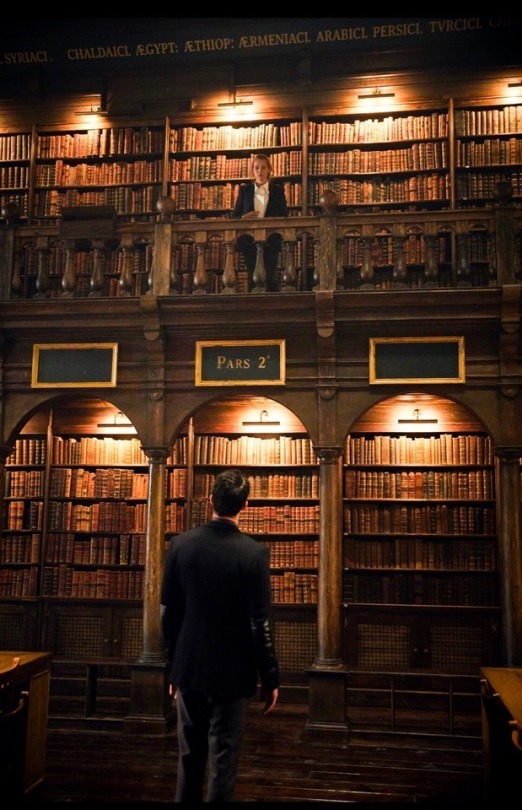
Another thing that surprised me, how they changed many scenes to have more Diana x Matthew scenes. Because lbr, we all know what sells. Haha.
From the very first time they meet, the scene in the book and TV show are very different. Also, quite understandably, due to the differences a more visual medium like TV has versus a book which can more easily describe stuff that can’t be shown. In the book, Diana has slightly more control over her powers, in that she vaguely knows it just takes a bit of desire, so to retrieve the book she needs, she just imagines the book in her hand and it flies there. She only realizes that Matthew is also there, noticing her use of magic, because as a witch she can feel when the different types of creatures are looking at her, so she feels his stare as cold spots in her back. In the show, Diana’s grasp of her powers are weaker and more erratic, so the book she hopes to get instead flys off the shelf and lands in Matthew’s hands.

In the book, Matthew’s initial realisation of his craving for Diana is much more reserved than in the show, though it’s through similar catalysts. On the show, we get that scene of Matthew sniffing Diana’s dropped sweater and just barely being able to control his predatory instincts, prompting him to momentarily run to Scotland to hunt. In the book, a similar thing happens, in that Diana leaves her sweater in his car from being driven home from yoga. It’s implied he got a similar reaction to her scent, though he only tells Diana about it later on, once he’s returned from Scotland.
Another beautifully added scene is the one before the dinner Diana invites Matthew to. In the book, it goes as expected. On the show, the addition of Peter Knox barging in beforehand to harass Diana, leading to Matthew rushing in with vampiric speed to stare down Knox is gr9 because there can never be enough growly protective Matthew scenes.
One aspect of Matthew’s initial stalking of Diana that I feel the show really improved on over the books, is when he breaks into Diana’s room to find Ashmole 782. On the show, he takes advantage of the fact that Diana is out rowing to look through her room to find it. In the book, he just creaks in while she’s sleeping and even makes sure she stays asleep by feeding her his blood. Kind of approaching Twilight’s Edward level of creepiness, though at least it’s more of a means to an end instead of some weird desire to watch Diana while she’s asleep.

Since they don’t usually show the whole thing on TV, unless it has a higher rating, I didn’t really catch on that they haven’t fully done the nasty at this point. Only realized it when I read that Matthew is specifically refusing to go all the way (for now. Until we learn why in Book 2 ;w;) and on a rewatch saw that yea, he’s just... using his hand or his mouth :x
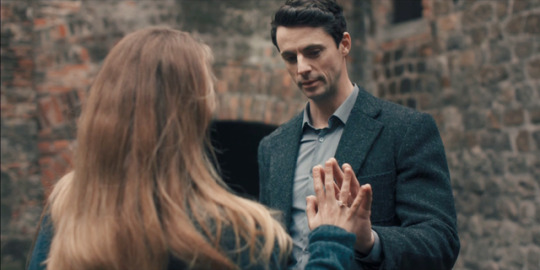
One thing I do enjoy in the books over the show is that there’s more time for Diana and Matthew’s relationship to slowly develop. When I first watched it, it felt a bit too fast to be honest, though I did still enjoy the chemistry between Matthew Goode and Teresa Palmer, and a lot of the bishmont scenes were 🔥 🔥 🔥 It was pretty obvious that a lot of scenes had to be cut out to fit everything into the 8 episodes. In the book, though they’ve also known each other in the same short amount of time, but the way Diana and Matthew’s feelings for each other gradually develop through several dates and yoga lessons (OMG the yoga) makes it seem less Insta-lovey.
Diana

As I stated at the beginning, the book and the show complement each other. On the show, Diana is shown as being extremely athletic, often rowing by herself or going for a run. It doesn’t really seem to have much significance other than showing that Diana has hobbies outside of her academic work and occasionally providing an excuse for her to be alone so she can be snatched up (yes we know the scene I’m talking about). In the book, there is actually an explanation for it. We are told that Diana’s power incontinence leads to a build up of adrenaline which leads to her panic attacks, an unfortunate effect of the spellbinding on her. To work off the excess adrenaline, she turns to sport as she hates having to rely on medication to regulate it. Also, as previously mentioned, book!Diana seems to have a bit more “control” over her powers whereas TV!Diana does’t seem to at all. She also seems to have more of a witch’s power for the third eye, seeing visions when she looks at certain objects, like Matthew’s armour.
Matthew

I would say the main difference between book!Matthew and TV!Matthew is his anger management. From Diana’s description in the book, in the beginning Matthew seems to have an extremely quick temper, being able to go from calm to furious in a matter of seconds, even over seemingly small matters. Later on, it is revealed that he has an inherited blood rage problem. But without knowing that, initially it just seems like a red flag issue and someone Diana should avoid. On the show, Matthew Goode portrays a Matthew (Clairmont) that is always tightly in control of himself, but not necessarily with a hair trigger fuse. His bursts of violence only appear when Diana is threatened so it seems more justified to the viewer. And book!Matthew’s eyes do the thing where they go all black when he’s in the throes of a blood rage. I’m interested to see how it will be portrayed on the show in the next 2 seasons. Honestly, TV!Matthew never seemed overtly prone to anger like in the books. Just the “usual” overprotective vampire growling and fighting. Guess we’ll have to see how the show is gonna portray it because it’s a pretty major point conflict in the relationship in book 2 and 3.
A bit of a minor detail but in the book, it is shown how impressive Matthew’s academic career is since his living quarters are in an exclusive area of the campus, as befitting his title as one of the very few with an All Souls scholarship.
Gillian (and her friendship with Diana)
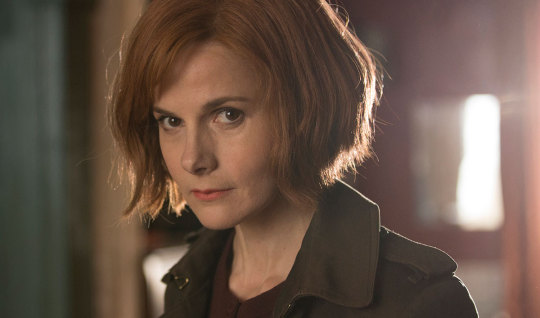
Book!Gillian is a bit more of a throwaway character than TV!Gillian. Book!Gillian seems to be more of a casual acquaintance to Diana, just another one of the Oxford area witches trying to get her to join the local coven. I like the modification in the series where they made her a closer friend to Diana. It gives a greater impact when Gillian ends up betraying Diana’s trust, spilling the secrets Diana thought were safe with a friend to Peter Knox. It amplifies the feeling of loneliness and isolation that Diana goes through when she learns there is no one in Oxford she can really trust, other than Matthew even though she’s only just gotten to know him. She is also portrayed as slightly more sympathetic on the show. In the book, she is just an example of the many witches in the area who despise other creatures, and thus looks down on Diana for fraternizing with a vampire. This disdain, plus her ambition to be a part of the congregation, leads her to doing Peter Knox’s dirty work, like breaking into Matthew’s lab and sending Diana the gruesome photos of her dead parents. On the show, she seems to have more of a timid personality, making her a bit of a doormat that is easily manipulated by Knox. She is also given a lower position, still being unable to qualify for tenure while Diana is one of the youngest to have done so at Yale, giving Gillian a bit of an inferiority complex. This makes it easy for Knox to feed her lies about Diana using her powers for her own academic gain, leading Gillian to carry out Knox’s dirty work in order to gain more of a status in her witchy community.
It’s also an interesting detail that later on, when Matthew sucks her blood as payback for breaking into his lab, on the show it’s presented more as him wanting to know what Gillian has seen and how much she was able to report to Knox. It kind of implies that the extra blood loss that lead to her death might have been due to her dragging herself all the way to the house of the coven leader, at least, that’s how I saw it. Matthew later on even mentions that he didn’t mean to kill her. In the book, since we’re not really shown the scene, it is just mentioned that Matthew sucked her blood and killed her for revenge. Since Matthew is one of the two main leads, and Gillian was a closer friend of Diana’s than in the book, it makes sense they would want to tone down the extent of Matthew’s culpability while still having Gillian end up dead.
Marcus (and his children. Or lack thereof)
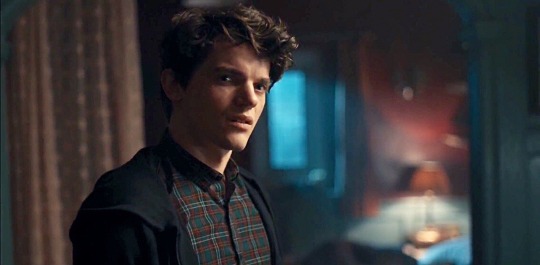
There’s a bit more of Marcus in the show than the book, which is nice. We see book!Miriam more in the beginning since she’s the one who guards over Diana in the Bodleian on Matthew’s behalf. Understandable as being Matthew’s lab assistant gives her access to the same areas in Oxford, unlike Marcus who works somewhere else. I liked the added interaction of Marcus and Diana where she asks him what food to prepare for her dinner date with Matthew, in exchange for letting him and Miriam draw her blood. It’s a cute scene.
We are first shown that vampires are increasingly failing to sire by TV!Marcus failing to save his friend, James. They then analyse his blood, proving that he has the same genetic markers as other cases of failed sires. In the books, it’s just a vague mention of it happening to other vampires. The show kind of gave me the impression that it was the first time Marcus had tried siring but in the books, he has a whole family of children in New Orleans. I’m curious how the show will incorporate that then, since they’re sort of an important plot point for certain events, especially in Book 3. Also, the point that Marcus attempted to sire James without asking for his permission first brings to mind Matthew’s previous siring of Cecilia that led to her suicide. It’s not given a huge emphasis on the show though it comes up twice, so having read the book Matthew’s anger at Marcus siring James without asking for permission is an extra D:
Pacing and plot changes The biggest difference between the book and the show, is that the book is written in a first person limited style, from Diana’s POV, with a smattering of third person limited chapters to show some scenes where Matthew is away from Diana. The show show employs more of a third person omniscient style. From the start, we are shown all the members of the Congregation, as well as other characters that loom in the background, slowly closing in on our main characters. It’s less of a jarring experience when certain events occur.
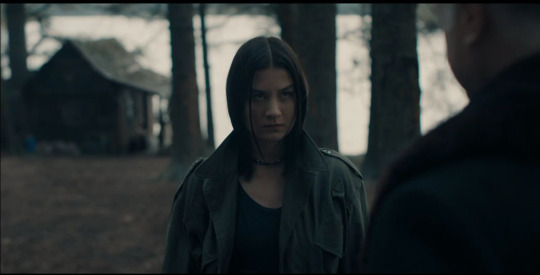
Satu In the show, we are shown from the beginning how Peter Knox recruits her into the Congregation, as someone who can take his side in Congregation matters. She is portrayed slightly more sympathetic as instead of just appearing in the middle to open up Diana, we see her already confronting Diana early on to try to gauge Diana’s powers. We also see her try to learn more about Diana by reading through Congregation archives. And we see Peter Knox’s power over her initially as he subdues her using his power. Also, like most witches, she is convinced that Matthew is using his vampiric powers to put Diana under his spell. Though these don’t justify the extremes she goes to, it is less of an abrupt shock when she appears to whisk Diana away from Sept-Tours and open her up to see Diana’s secrets and true powers.

Juliette Another whoa-that-came-out-of-nowhere antagonist in the book. In the show, as with Satu, we see her slowly closing in on our main characters as she is shown to have an obsession with “Matthew”, under Gerbert’s control. Though it does seem kind of :x that Marcus and Miriam didn’t warn Matthew when Juliette broke into his room. It was only a matter of time before she tracked him down to Diana’s home in Madison.
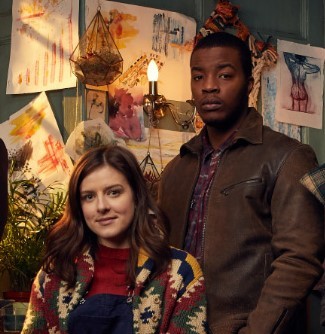
Sophie and Nathaniel Definitely preferred the introduction of Sophie and Nathaniel in the series than the book =w=;;; In the book, when they show up out of nowhere to hand Diana one of the items she needs to travel to 1590, it seems a bit Deus Ex Machina-y because we are only following the events through Diana’s limited POV. In the show, we see Sophie slowly try to decipher who she is supposed to hand her family heirloom to, through her prophetic dreams. The idea of creatures intermixing is also gradually introduced as we find out that Sophie is a daemon born to witches, carrying a witch baby. Also implying that her prophetic dreams is due to her witchly heritage. It also shows us, from the start, Nathaniel’s proficiency in computers, which will come in handy later on.
Deleted Scenes It’s a 579 page book that has to be condensed into less than 8 hours of screen time so of course some things have to be cut.
Yoga Oh the yoga scenes. It would have been vaguely hilarious to see Matthew doing yoga XD Also, it added to Diana and Matthew slowly getting to know each other, as well as the possibility of all creatures getting along. Pacing-wise, it would probably have been a bit too early in the show to introduce the concept of all the different creatures working together in harmony. Throughout the 8 episodes, there’s a nice development from outright hatred, with Gillian’s attitude towards Diana hanging out with Matthew, begrudging cooperation, within the members of the Congregation, tentative co-existence, with Nathaniel’s daemon group talking about how they interact with other creatures and humans, to the shadow congregation/conventicle that Diana’s family, Matthew’s family and Sophie’s family end up forming towards the end of the season.
The ghosts Another practical cut because plot-wise, they don’t really add as much. It would have been fun to see Granny ghost and the other’s checking Matthew out the first time he steps into the Bishop house XD
Season 2 speculations
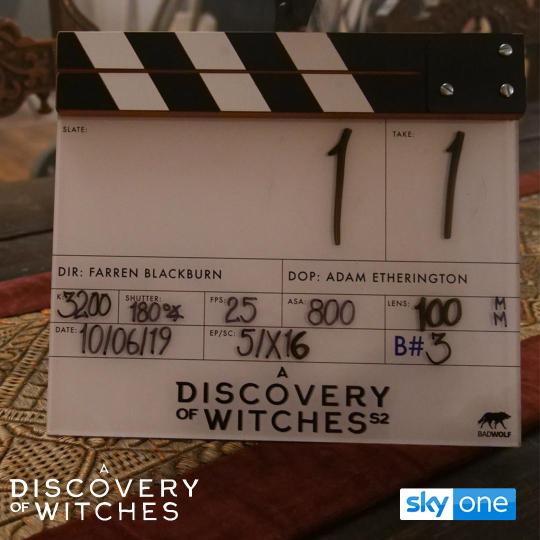
- Suddenly watching a period piece. Haha. Though considering the ending of Season 1, it’ll probably expand on the story and intersperse bishmont’s 1590s shenanigans with present day details, like Marcus’s leadership of the Knights of Lazarus and what happens between Emily and Gerbert - bloodRage!Matthew. Yes please. I AM HERE FOR IT 🔥 🔥 🔥 - T H E M A R R I A G E and finally getting to see bishmont do the do 😏 - Diana’s R A I N B O W magic. Also, I honestly still can’t quite picture what the knotting that she does with her magic looks like so it’ll be interesting to finally get to see it on screen. - Also quite curious to see if they’ll leave the loss of their first child in. On the one hand A N G S T plus a parallel to Matthew’s first marriage to Blanca. On the other hand, is there enough screen time? Also, the whole fear of hereditary blood rage could cover the same A N G S T.
Honestly, there’s so much plot to cover, I’m curious to see how they’ll do it in 10 episodes (EDIT: thanks for the update on S2′s ep count @adow-trash . Sorry I’m super new to the fandom. Only started diving in on Monday)
43 notes
·
View notes
Text
Psycho Analysis: Lucy
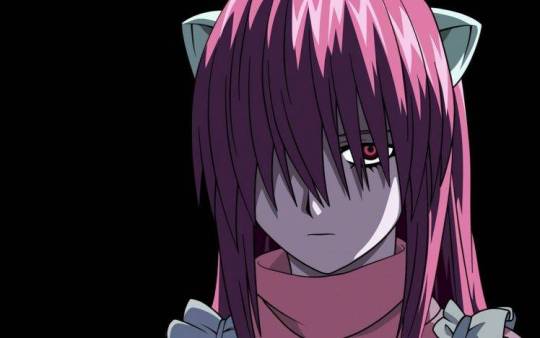
(WARNING! This analysis contains SPOILERS!)
It’s not very often you see a series where the villain is the main character, but then again it isn’t very often you see a series quite like Elfen Lied. The series is dark, foreboding, and gory, and a lot of that has to do with its protagonist, the Diclonius woman Lucy. Lucy is one of the most brutally tragic villains you’ll ever see, between her incredibly nightmarish childhood to the constant torment her very nature puts her through as a mutant. It all adds up to a very rich, complex character... though one that ends up not as fully realized as she could have been.
Actor: Kira Vincent-Davis portrayed Lucy in one of her star-making roles. The other? Osaka from Azumanga Daioh. She definitely delivers an excellent performance here, and it is easy to see how she managed to get such a varied career out of this. She knows just how to inject the right emotions into Lucy’s voice, and when Lucy is in her Nyuu personality she manages to fill the latter’s Pokemon speak with enough character that you get what she’s going for.
Motivation/Goals: Lucy is a Diclonius, and as such she has internal homicidal instincts that make her desire to slaughter as many people as humanly possible; coupled with the horns, the name she ends up being given (her true name is Kaede, but she ends up being called Lucy), and the fact she ends up embodying each of the Seven Deadly Sins if you read into her actions, and Lucy ends up a symbolic stand-in for the Antichrist. Of course, as a child, she didn’t really grasp this and in fact actively tried to suppress these feelings, but unfortunately fate decided to deal her a very poor hand.
First was her only source of happiness at the orphanage she grew up in, a puppy. A puppy that her bullies found out about, and in one of the most infamous moments of the series, beat it to death in front of her… and in turn, begin her descent into villainy as she slaughters the entire lot of kids, from her bullies to the girl she had befriended earlier who decided to snitch to the bullies about the puppy.
Second was what she felt was a betrayal at the hands of her only friend, Kouta. After he got her to open up and befriended her, she saw him at the festival with his female cousin and became insanely jealous, thinking he chose another girl over her… and so she went on a killing spree, which culminated in killing Kouta’s father and sister right in front of him.
And finally, her last ray of hope, a human who she had befriended was injured by the people who finally took her into custody… she died of her wounds, but Lucy wasn’t told until after she was imprisoned under the condition that they save her. When she finally gets a chance to escape, her sole motivation seems to be staying near Kouta again and try to find some way to apologize for her heinous actions, though even she realizes she’ll never be able to atone for what she did to him.
This brings about a pretty interesting facet of her goals: she slowly starts to defrost and gain more humanity the more time she and her split personality Nyuu spend with Kouta. It is in fact a major part of the story that she slowly becomes less evil as time goes on and she begins to develop, though by “less evil” I mean to say that at best she is an anti-hero, one who has no qualms about brutally dismembering anyone who dares to harm Kouta or herself.
This also ties into one of the major themes of the series: nature vs. nurture. Obviously, Lucy’s internal genetic desire to wipe out humanity is her inherent nature, but one also needs to look at what drove her to her killings; she was bullied, abused, and faced prejudice, betrayal, and scorn all around her for her entire childhood. Notice how when she’s shown the simplest compassion, she immediately starts to fall for that person and seems to want to do better, before a simple misunderstanding causes her to react in a volatile manner. It may seem over-the-top and disproportianate what she does to Kouta, but this is what her peers and caretakers molded her into: a violent misanthrope who clings desperately to even the tiniest shred of kindness in the world, and when she feels betrayed she lashes out and kills in a fit of rage, giving in to her violent nature. After gaining the amnesia during her escape at the start of the series and gaining her split personality, she is taken in yet again by Kouta and treated as a friend, an equal, and this begins Lucy’s ascent from pure villain protagonist to very, VERY dark anti-hero.
Personality: Lucy is a cold, cynical, and bitter woman due to the numerous tragedies she experienced, but she is no emotionless husk; if there is one thing that is true about Lucy, it is that her capacity for love is one of her greatest strengths and greatest weaknesses. Love is what drove her to kill Kouta’s family out of jealousy, it’s what drove herself to sacrifice herself for Aiko (the girl she befriended before being captured), it’s what drives her the most throughout the series really. Her capacity for love is only even closely rivaled by her capacity for hate.
Final Fate: In the anime, Lucy finally confesses the truth to Kouta, and while he outright says he can never forgive her for what she did, he is at least a little more sympathetic to her plight than he was in the manga, where he outright said he hated her (though he did at least say her split personality Nyuu could stick around as long as she promised not to kill anyone). She then makes a heroic sacrifice against the army who is after her, one which she may or may not have survived. The ending is rather ambiguous, as opposed to that of the manga in which she is really and most sincerely dead after nearly bringing about the apocalypse in a fit of rage.
Best Scene: There are a lot of contenders, but perhaps her finest moment is the scene where Lucy as we know her is truly born, baptized in the blood of the bullies who killed her dog.
Best Quote: “When you're miserable, you need to make someone even more miserable than yourself.”
Final Thoughts & Score: Lucy is an amazing character. Her character arc is a depressing, heartrending rollercoaster showing her descent into the darkest depths of despair, cynicism, and evil before she begins to slowly but surely rise again, climbing out of the dark if only just a little bit. She’s stoic and sadistic, monstrous and vicious, cruel and uncaring… but at the same time, she has a boundless expanse of love inside her broken, battered heart, and a burning passion that drives her actions and the plot. She is shattered, she is flawed, but she is so very interesting.
A really fascinating aspect of her is how she deconstructs the tropes of the cute monster girl and magical girlfriend. The former is deconstructed by the fact that, despite being appealing to the viewer and us being given no reason to think she’d be unattractive to the humans of her world, her horns and other differences cause her to be mocked, tormented, and persecuted by her peers, with said persecution ultimately pushing her over the edge and causing her to become a serial killer. For the latter, her powers are incredily, seriously dangerous, as her invisible arms (or vectors, as they are called in the series) can easily dismember and when not dismembering infect the reproductive capabilities of whoever they touch, and there is also the fact that they are part of the contributing factor that drives her to madness.
Lucy gets a 9/10. She’s a very impressive villain, and one who has one of the most fascinatingly tragic backstories. In fact, she has the backstory by which all tragic backstories should be judged; if your villain wants to destroy the human race and yet their backstory wasn’t a horrendously cruel conga line of trauma the way Lucy’s was, you may want to rethink that backstory. It really is the tragedy and the way the series unfolds to show you just how she became the way she is that makes her so great; the only reason I don’t give her perfect marks is because the manga goes into far more detail in developing her, as the anime was made while the manga was still ongoing.
And you know what? That might honestly be for the better. Lucy in the manga was far more insane, far more evil, and far easier to see as irredeemable, though even there she had moments of kindness and compassion that ultimately belied her true nature buried under the years of systematic abuse and betrayal. In the anime, while she is still a bitter, jaded serial killer, she comes off as bit more worthy of redemption; she revels far less in the actions she takes and seems to act in her adulthood more out of self-preservation than anything, as she harms only those who have wronged her rather than people who just get in her way. It does end up making it more believable when Kouta offers his sympathy at anime’s end; this version of Lucy seems more like a broken monster who does all she does because at this point it’s all she knows and all she thinks she can be rather than someone who all too often indulges their twisted genetic instinct. I would have much preferred to see this Lucy receive the culmination to her character that the one in the manga did, but sadly that did not come to pass. We are left with something brilliant, but also something that could have been even more heartbreakingly beautiful in its tragic poignancy.
45 notes
·
View notes
Text
Riverdale Couples & Ships as Romantic Tropes (Part I) ❤️
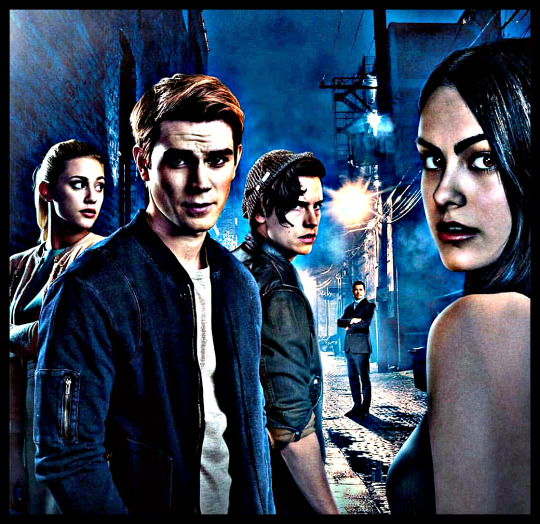
In this list, I’ll be listing the Riverdale ships and couples (both teen and adult) with the romantic tropes that best represent their relationship on the show. In case you’re wondering where I got the tropes from, I got them from TVTropes.org. This list of couples and their romantic tropes is not a rankings list like my previous other lists which were rankings based on percentages. Because there are so many couples, I have decided to split the lists in two parts. Have fun reading!
#25. Archundy (Archie Andrews & Geraldine Grundy; ROMANTIC TROPE: TEACHER/STUDENT ROMANCE)


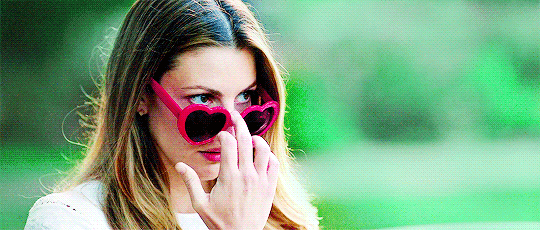
Teacher/Student Romance
"I've got it bad, got it bad, got it bad, I'm Hot For Teacher."—Van Halen
It is a pretty good bet that just about any show that features adults and teens interacting in an academic environment will eventually explore a romantic relationship between a teacher and a student. The basis for this type of relationship — if it's actually a romance and not just a Sextra Credit arrangement — can either be the adoration and respect toward the teacher and mentor figure or the teacher's protective and caring instincts, or both. The illicit, forbidden, and most often scandalous nature of these relationships can be mined for angst, and generally doesn't cause real life issues because the actors themselves are generally all above the age of consent thanks to Dawson Casting. But even if the student is eighteen or in college, this sort of extracurricular activity would still be a massive breach of professional ethics in most of the world and in some jurisdictions is considered illegal, regardless of age, in some circumstances (some teachers have been charged for relationships with high school students, even if the relationship didn't begin until after the student turned 18 and the teacher her/himself was only a few years older). Even if it was not illegal, the scandal that would erupt from this socially unacceptable affair would be so devastating it would basically cost a teacher or professor his or her job forever. There are usually different levels of moral endorsement of the relationship, depending on the genders of the participants. Relationships between male teachers and male students are condemned the most harshly. When a male teacher and a female student are together it results in the teacher being viewed as a pervert and sometimes the student being slut shamed. When it's the other way around, a female teacher with a male or even a female student is taken far less seriously. An even more outrageous double standard is that emphasis is often placed on how attractive said female teacher is — the more attractive said teacher, the more acceptable the relationship is. That said, the trope in fiction probably will involve a Hot Teacher, if only for fanservice purposes. An author might attempt to make this relationship less squicky by having the student fulfill the Wise Beyond Their Years trope, by keeping things to Courtly Love only, or by making both participants older — a graduate or doctoral student falling in love with their professor is less likely to cause moral outrage than a high school student doing the same thing due to both participants being adults, though the professional ethics of the situation remain pretty much the same. The relationship may be initiated by a Fille Fatale. A subtrope of Unequal Pairing. Compare Mrs. Robinson. See Likes Older Men, Likes Older Women, and Stacy's Mom for young people lusting after older people in general, Precocious Crush for a more innocent variant, Age-Gap Romance for when there's a significant age difference between them, and Mentor Ship. There's a version specific to magic users called Merlin and Nimue, which takes its cue from the Arthurian Mythos where Merlin formed such a pair with several women. Teacher/Parent Romance occurs when a teacher falls for their student's parent. This group of tropes is among The Oldest Ones in the Book. Although generally frowned upon in Real Life today, it's had varying levels of acceptance throughout history. It was most famously acceptable in Ancient Greece, where it took the form of Lover and Beloved.
#24. Jasolly (Jason Blossom & Polly Cooper; ROMANTIC TROPE: KISSING COUSINS)
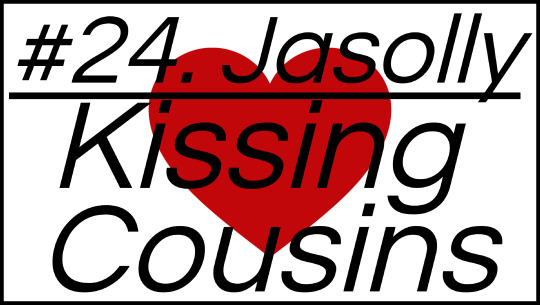


Kissing Cousins
"If you're tired of beating around the bush, why not shake the family tree? A hot cousin might fall out."—Stephen Colbert
Romantic/sexual relationships between cousins (meaning, generally, first cousins) are a phenomenon that has been more accepted in some cultures and eras than others. A great many cultures today accept it, including a majority of the industrialized world. Marrying one's extended relatives (which is technically known as clan endogamy) seems to have been common in human evolutionary history, since hominids usually lived in small nomadic bands with few available sexual partners. At the other end of the spectrum, much of the modern U.S.A. considers cousin marriage completely taboo, so Hilarity Ensues at the very mention of it. People from backwoods areas (especially the Appalachian Mountains) are often the preferred butt of many bad jokes as well as occasional bits of Self-Deprecation for the alleged prevalence of Kissing Cousins in their culture. Despite the taboo, cousin marriages are legal in about half the states in the U.S.A., though not as much in the backwoods areas and more in the modern industrialized states, the opposite of what one might expect from hearing all those jokes. Legal or not, these marriages are still not very common due to the lingering cultural taboo. All states permit marriages between second and third cousins, but even these are looked at funny. In the UK, first cousin marriage is unusual and would be regarded as rather odd, but not with the same severity as the US. Second cousin marriages and beyond would be seen as unremarkable. Expect some strong Values Dissonance between the media from the US and other countries, and between certain modern works and works from the nineteenth century and earlier, when the taboo was sometimes non-existent or even inverted. Full scholarly debate on why some cultures would forbid cousins, or even specific types of cousins, to marry, while others ignore or even encourage it, rages on, and lies beyond the scope of this wiki. According to both Oxford's and Merriam-Webster's Dictionaries, the original definition of kissing cousins was simply a relative known well enough to be given a kiss in greeting, although this meaning has long since fallen by the wayside. Check out Incest Is Relative for more closely related tropes. NOTE: This trope is for cases of actual relationships between cousins. Cousincestuous subtext goes in Incest Subtext.
#23. Joaqevin (Joaquin DeSantos & Kevin Keller; ROMANTIC TROPE: BURY YOUR GAYS)
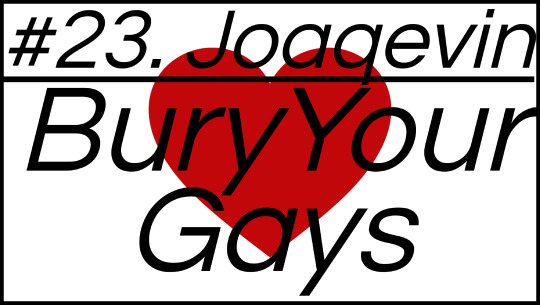

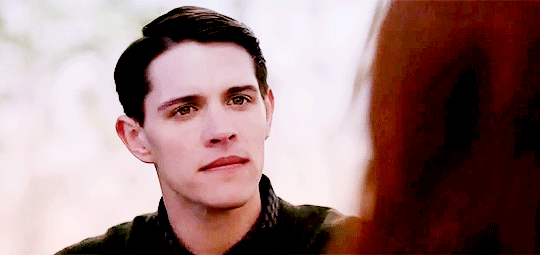
Bury Your Gays
"[Television] has yet to recover from the [2015/16 and 16/17] seasons, which included the deaths of an overwhelming number of lesbian and bisexual women characters. These deaths were often in service of another straight, cisgender character's plotline, and sent a toxic message to audiences. This decades-long trend — referred to in popular culture as "Bury Your Gays" — has made countless headlines in the past year, educating both viewers and creators alike on just how ubiquitous this trope has been."— Opening statement to the 2017/18 GLAAD (Where We Are on TV Report)
The Bury Your Gays trope in media, including all its variants, is a homophobic cliché. It is the presentation of deaths of LGBT characters where these characters are nominally able to be viewed as more expendable than their heteronormative counterparts. In this way, the death is treated as exceptional in its circumstances. Thus, it can be fairly said that, in aggregate, queer characters are more likely to die than straight characters. Indeed, it may be because they seem to have less purpose compared to straight characters, or that the supposed natural conclusion of their story is an early death. Also known as Dead Lesbian Syndrome, though that name has largely fallen out of use post-2015 and the media riots about overuse of the trope. And, as this public outcry restated, the problem isn't merely that gay characters are killed off: the problem is the tendency that gay characters are killed off in a story full of mostly straight characters, or when the characters are killed off because they are gay. However, sometimes gay characters die in fiction because, well, sometimes people die. There are many Anyone Can Die stories: barring explicit differences in the treatments of the gay and straight deaths in these, it's not odd that the gay characters are dying. The occasional death of one in a Cast Full of Gay is unlikely to be notable, either. Can be seen as Truth in Television in some cases, as gay and lesbian people are at a substantially higher risk for suicide and assault — see the tropes Gayngst-Induced Suicide and Homophobic Hate Crime. The fact that AIDS hit the gay male community most prominently provided potent fresh fuel for this long running trope (which, like many things about the eighties, still has an effect on more recent works). There may also be a higher prevalence of this trope in Period Fiction because of its supposed realism since historically there was lots of homophobic persecution — though undoubtedly plenty of acceptance, too. The exact opposite is found in Preserve Your Gays, often a reaction to this.
#22. Kevoose (Moose Mason & Kevin Keller; ROMANTIC TROPE: GAY GUY SEEKS POPULAR JOCK)
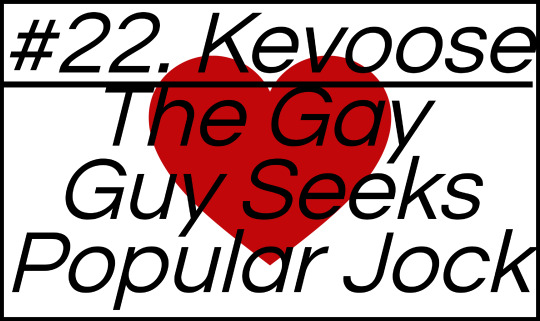
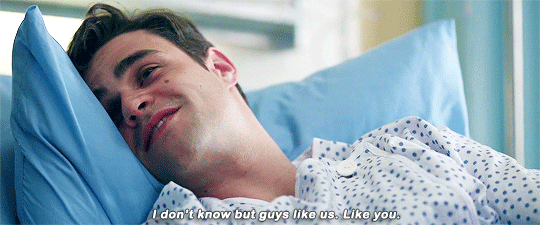
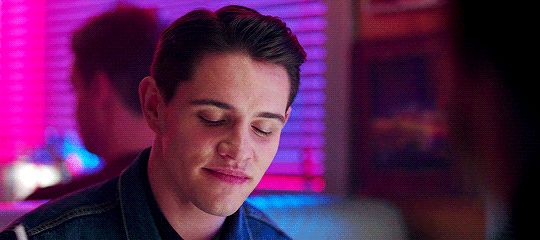
Gay Guy Seeks Popular Jock
LGBT media and LGBT characters featured in media have grown in prominence the past few decades. As the visibility grew, a common romance trope was employed over and over again enough that it became cliché: A gay teenager (who is the Audience Surrogate) ranging from Camp Gay to Adorkable to Shrinking Violet falls in love with/actively pursues/crushes on/is paired up with a popular, muscular and (usually) closeted jock. So many gay stories use this trope for several reasons, best written by Brent Hartinger, author of Geography Club.
The Star-Crossed Lovers trope is Older Than Dirt and used for so many love stories already, so it stands that it can be used for a same-sex tale of romance and woe.
Rule of Drama: The geeky gay and jock not only come from different "classes" (so to speak) but also face different hurdles in a Coming-Out Story: The geeky gay always is less conventionally masculine, so he doesn't have much to lose by being honest and open. The jock character, by contrast is a Straight Gay, and by coming out may lose a lot more, especially dropping down the social ladder which can lead to tons of conflict and obstacles for the pair getting together.
Most of these writers are gay and this trope could be construed as a form of Wish Fulfillment: The shy, awkward boy landing a popular handsome athlete is a pretty common fantasy amongst gay men, so it stands that this convention would be pretty prominent.
While a common fantasy, this trope is also Truth in Television as this kind of pairing does indeed happen in Real Life. See also Sensitive Guy and Manly Man, Masculine–Feminine Gay Couple, and Star-Crossed Lovers. Frequently employs Gayngst and the Armored Closet Gay trope. See also Single Girl Seeks Most Popular Guy and All Guys Want Cheerleaders for the heterosexual versions of this trope.
#21. McKeller (Tom Keller & Sierra McCoy; ROMANTIC TROPE: MALIGNED MIXED MARRIAGE)



Maligned Mixed Marriage
"Who can feel sympathy for Desdemona? A woman who, born and educated to a splendid and lofty station in the community, betrays her race, her sex, her duty and her country, and makes a runaway match with a blackamoor."—John Quincy Adams
A common source of conflict for a set of married protagonists (or a couple of Star-Crossed Lovers) is for the couple to be of different races among very unaccepting folks. They will be pressured to break up/divorce by family and friends and community, ostracized, exiled or forced to flee, maimed, or murdered, etc. Their children will be likewise persecuted, perhaps more so than the parents, for complicating racial relations and being inherently 'untrustworthy' due to not being fully one race or the other. Even if the adults are fine, other Kids Are Cruel after all. Expect the child to eventually pop the question about whether there's something inherently and incurably wrong with them because of their genetic heritage. And of course, sometimes it's a mixed species marriage, or one between a muggle and a mage, complete with attendant prejudice. On the plus side the scifi/fantasy elements mean the kid is likely to be The Chosen One, a Half-Human Hybrid, a Dhampyr, or perhaps even a Hybrid Monster with really cool powers. That makes up for it, right? Some examples of interracial marriages that earn disapproval can be found in Mighty Whitey and Mellow Yellow, Black Gal on White Guy Drama, and Where Da White Women At?. For mixed species marriages, see also Vampire-Werewolf Love Triangle. In Real Life, mixed-race marriages can be everything from completely accepted to something you only do if you've got a death wish. Thankfully, in many places it's skewed towards the "completely accepted" end of the spectrum, and a great way for someone to reveal themselves as a severe jackass is to show bigotry towards mixed couples. Mixed-race marriages seem to be one of the last bastions of racism. Many opponents of interracial marriage claim to oppose all other forms of racism including genocide, different legal rights, and the physical segregation of races to prevent cultural contamination (and some claim to have friends of other races). However, they generally argue that that it's cruel to have mixed-race kids because they see race as the sole/most important element of collective identity. This makes the existence of people who blur the boundaries between races distressing for people of those races, who will see their identity as being under threat and in their illogical rage target the unfortunate mixed-race children in their midst. Of course, race is just one element of collective identity and while it can be very important to some people this is by no means a given. In general, mixed-race children tend to have about the same level of trouble that their parents have — less if they look like one race or the other instead of an obvious mixture, or live in a society that doesn't care about race. In stories that take place in communities where "race" isn't a defining factor in classifying humanity (like ''some'' of the 19th century USA, East Asia, or Russia), a "mixed marriage" could mean many other different things: mixed ethnicity ("ethnicity" here being vaguely synonymous with "nationality"), mixed religion, or mixed class. Due to Values Dissonance, many of these other "mixed" marriages tend to be Dead Horse Tropes in fiction (at least in the Anglosphere), though they do surface occasionally: consider My Big Fat Greek Wedding, which mines humor from the "scandal" of a ('white') Greek-American woman choosing a ('white') Anglo-American man as her husband... a thing no longer scandalous in the late 20th century, but most certainly was just a few decades previously. Truth in Television, of course, as there are still people who feel this way. Although anti-miscegenation attitudes are not only found in the classic cases of dominant, traditional, "purity"-seeking communities. Notably, some minorities also vocalize disdain for "disloyalty", stemming from the considerable culture-driven asymmetry in cross-race relationships — a subtle but persistent visual reminder of imposed inferiority — and frustrations in changing the narrative over discomforting perceptions of hyper-attractiveness or lack thereof. Then there are some who are simply pricks. But any of these justifications can end up invoking the trope. To be clear, this trope can cover any romantic relationship, not only matrimony. We just like alliteration here.
#20. Fredary (Fred Andrews & Mary Andrews; ROMANTIC TROPE: AMICABLE EXES)
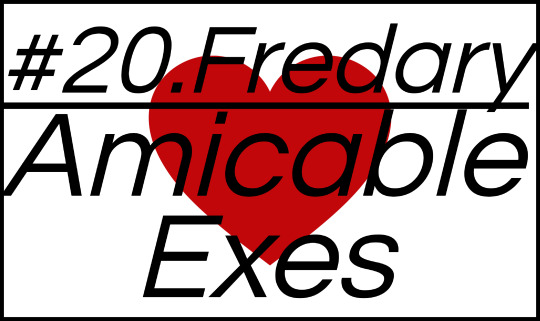


Amicable Exes
"It's things like using force together, Shouting till you're hoarse together, Getting a divorce together, That make perfect relationships."—Company ( "The Little Things You Do Together")
So, people who break up must indefinitely hate each other, right? Wrong. Increasingly common in media are situations where a divorced couple still get along for the most part, and in many cases still care about each other even though they're no longer together. In many cases the divorce happened because of distance, circumstance or the simple fact that people change rather than infidelity, betrayal or other serious problems, and the fact that they got divorced is treated as a fact of life rather than due to a flaw in the people. Both parties also generally agree that it was for the best for both of them. It's also pretty common for couples who broke up because of Incompatible Orientation or who were each other's Last Het Romance to end up this way. If there are children from the marriage they are shared without much complaint, and the amicability of the parents can often be interpreted as being partly for their sake. As such, this tends to show up in children's cartoons, perhaps as an attempt to counter the stereotype of the children of divorced parents being largely unhappy. May involve a Visit by Divorced Dad that will usually go well, and for the most part any Divorce Assets Conflicts are avoided or settled reasonably. The increase in this trope can be attributed in the dramatic shift in divorce rates and public perception of those who have gone through with divorces in the last 50 years (i.e. between the 1950s and the start of the 21st century). While divorce used to be scandalous, it's now a fairly common occurrence, and this trope reflects the view that it's just a fact of life that doesn't have to permanently poison a relationship. Sometimes it even results in Divorce Is Temporary, though this is less common in more realistic works and those aimed at children due to being a Family-Unfriendly Aesop ("wish hard enough and your parents will get back together!"). Can apply to non divorced former couples as well, thus the name. If someone's current and former squeeze get along well with each other, it's The Missus and the Ex. Compare Working with the Ex and Sex with the Ex. No, this is not about friendly .exe files.
#19. Clinelope (Clifford Blossom & Penelope Blossom; ROMANTIC TROPE: ARRANGED MARRIAGE)


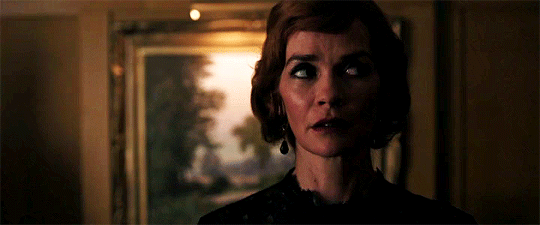
Arranged Marriage
"We who are of noble blood may not follow the wishes of our hearts."—Jane Olsen (The Cabinet of Dr. Caligari)
An Arranged Marriage is, quite simply, the idea that someone is going to choose your spouse for you. The way an Arranged Marriage is treated by the plot will be dependent on place and time. For most of human history, arranged marriages were the norm because "marriage" was less about the union of two souls and more about the union of two families. The rise of the "Marry for Love" ideal didn't really start in Western culture until the 16th century, and there are places on Earth where it still hasn't. Additionally, the "Marriage Before Romance" trope often went hand-in-hand with arranged marriages. While the priority is, again, the union of two families, that union is dependent on the stability and comfort of the two people getting married, so the two families would try their best to come up with a Perfectly Arranged Marriage. The couple's happiness just wasn't the main goal the way it is in Western marriages today. However, the one thing that is almost always present in an arranged marriage is tension. Most people don't really want to marry a total stranger (much less have sex with them), and if that total stranger turns out to be a complete rogue and a cad, it may be necessary for the heroes to spring into action and rescue the hapless member of their group who is being forced to walk down the aisle. (Of course, being Big Damn Heroes, they'll have to do so in the most overblown and dramatic way possible.) Sometimes, the person in the arranged marriage takes matters into their own hands and becomes a Runaway Fiancé. The "aggrieved" party may claim Breach of Promise of Marriage in response, as arranged marriages tend to be viewed as legally binding commitments by those who initiate it. Alternately, there's a Love Triangle. The character of the suitor is less likely to be important in those cases, but they generally won't look kindly on the outsider's interference. Conversely, an Arranged Marriage can be used to lock the hero and heroine together so that their disputes can not end with one of them washing their hands of the other. A common tactic is for the daughter of a wealthy but common family to be matched with the Impoverished Patrician, for his title: Nobility Marries Money. Occasionally, it's the other way around, with a titled daughter and a moneyed son. Families may even pledge infant children in marriage pacts that cannot be concluded until many years later. Both in fiction and in Real Life, royal children (sons as well as daughters) were used as pawns in the political game cementing alliances and peace treaties with their marriages. You might say it was their job to take part in such Altar Diplomacy. The Arranged Marriage is not to be confused with: a Childhood Marriage Promise (whereby a prepubescent couple voluntarily pledges their own non-legally-binding, future troth); a marriage which may arise out of convenience; or a marriage that arises from some kind of cultural mistake. For clarity's sake, the Arranged Marriage trope will deal only with more binding, traditional types of unions. See also Parental Marriage Veto, You Have Waited Long Enough, Old Man Marrying a Child, Homosocial Heterosexuality, Royal Inbreeding, and Marriage Before Romance. A Shotgun Wedding is a short-notice forced marriage. If someone agrees to an Arranged Marriage but loves someone else, Courtly Love may be involved. If the people doing the "arranging" in the marriage aren't the parents, that's a Bureaucratically Arranged Marriage. Often involves Prince Charmless and Rebellious Princess. At least recently, one of the potential spouses was as likely as not to try to defy this. When the audience really doesn't want this marriage, expect the Big Damn Heroes to show up right at the Speak Now or Forever Hold Your Peace line. To see the types of follies and foibles associated with modern dating services, see Dating Service Disaster. Supertrope to Perfectly Arranged Marriage. Subtrope of Marriage of Convenience. Contrast Marry for Love. Compare And Now You Must Marry Me. Compare and contrast Fourth Date Marriage, where the couple likewise barely knows each other but it was Love at First Sight.
#18. Halice (Hal Cooper & Alice Cooper; ROMANTIC TROPE: AWFUL WEDDED LIFE)
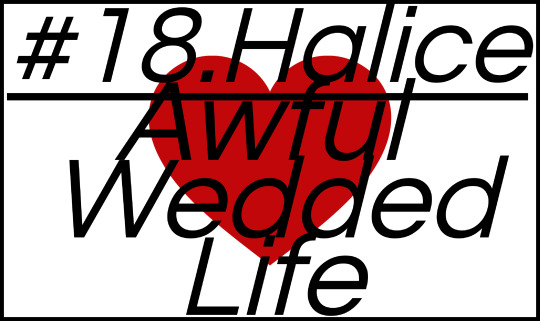


Awful Wedded Life
Take it from me Spaghetti Man, better dead than wed."— Richie Tozier, IT
The depiction of monogamous marriage as rather like a long, slow, exquisite torture by a sadistic god from whose malicious clutches escape is impossible. Husbands are child-like buffoons who watch too much football, leave the toilet seat up, ogle hot women, and forget anniversaries. Wives are frigid, nagging, hateful shrews with zero interest in sex. Children destroy your home and what little peace of mind you have left, while waiting their turn to perpetuate the cycle. Obnoxious In-Laws serve to add to the misery. The audience may be left wondering, "Why don't they just get a divorce, if they're so miserable?" Married... with Children was probably the first time this trope was the main focus of an American sitcom, but it's been a mainstay of British shows since The '50s. It is also a staple of Borscht Belthumour, but that may be less to do with venom than with Jews Love to Argue or Jewish Complaining. The name, for those who don't get it, is a reference to the line of the traditional wedding vows, "Lawful wedded wife". Similar to No Accounting for Taste, but you'll rarely (if ever) see the Aww, Look! They Really Do Love Each Other moments occasionally found in that trope. Compare The Masochism Tango, Belligerent Sexual Tension, Like an Old Married Couple, Dead Sparks, and Married Too Young. Contrast Happily Married for the opposite and Happy Marriage Charade for when this trope pretends to be Happily Married. Unfortunately, Truth in Television for many people until quite recently, in eras with some combination of marriages being arranged for family advantage (or some other type of Marriage of Convenience) rather than created by mutual attraction, divorce being impossible or hugely disapproved of, or unintentional pregnancy leading to a choice of marriage or social ostracism.
#17. Fralice (Fred Andrews & Alice Cooper; ROMANTIC TROPE: AW, LOOK! THEY REALLY DO LOVE EACH OTHER)

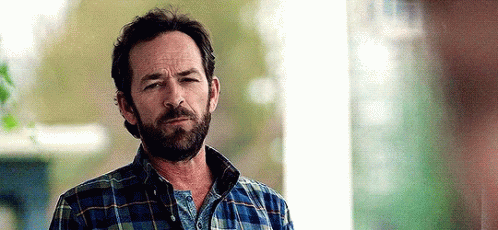
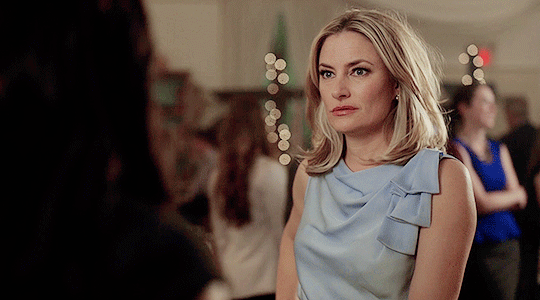
Aw, Look! They Really Do Love Each Other
When a couple/potential couple — who spend the entirety of the show yelling at each other, insulting one another, stabbing each other in the back, etc. — have a moment when they reveal that, deep down, they really care for one another. Awwww. Often takes place in a humorous rushing-to-your-spouse's-defense manner, where one of them angrily defends the other against the same kind of insults that they themselves like to dish out. The common line is: "Nobody insults/beats up/threatens my wife, husband, boyfriend, girlfriend but me!" If this relation is between friends then they are Vitriolic Best Buds. If it is between siblings, then it either combines Big Brother Bully and Big Brother Instinct or is Thicker Than Water. If the romance part comes without warning or justification, the trope may fall flat, since it comes out of nowhere when the previous context of the story makes it seem like they have nothing to love about each other. When couples don't even have these moments you get No Accounting for Taste. See also Defrosting Ice Queen, Slap-Slap-Kiss and Belligerent Sexual Tension. A couple version of a Pet the Dog moment.
#16. Halelope (Hal Cooper & Penelope Blossom; ROMANTIC TROPE: YOUR CHEATING HEART)

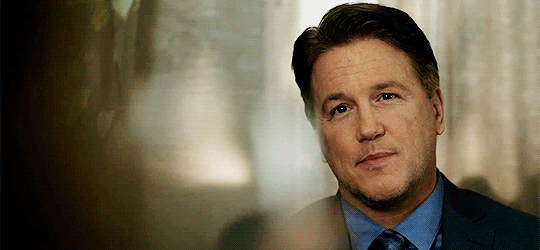
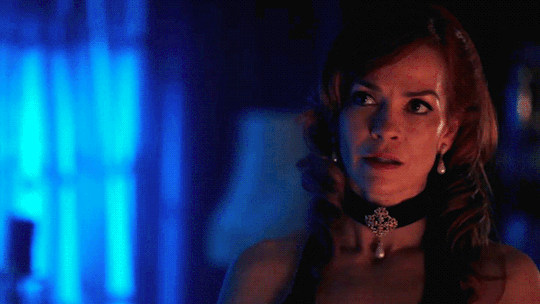
Your Cheating Heart
"Your cheatin' heart will make you weep, You'll cry and cry and try to sleep. But sleep won't come the whole night through, Your cheatin' heart will tell on you."—Hank Williams ( "Your Cheatin' Heart”)
Two-timing, playing away from home, having a bit on the side, going behind your partner's back, adultery, infidelity... There are a lot of names for cheating on your partner, but most of them have the same outcome: a world of hurt. Most of us recognize this type of plot: Bob is married to Alice. One day, Bob sees Carol at a club and is attracted to her. Perhaps things haven't been going so well with Alice for some time. Maybe they just had a major fight and Bob stormed off. Or maybe his marriage is perfectly healthy, and Bob has no excuse. Whatever the reason, Bob flirts with Carol, which eventually leads to a sexual or romantic relationship and the various things that entails. But here's the thing: Bob doesn't tell Alice about it. He doesn't dump her, he doesn't tell her that he thinks the marriage is on the rocks, he doesn't talk to her about Polyamory or swinging, he doesn't even ask for "more space". He continues to play the part of her husband, and expects her to continue being his wife, hoping that Alice won't notice when he starts coming in late for dinner, or ask him about the mysterious expenditures on their joint account. Sometimes, just to really play Alice for a sucker, their marriage will seemingly improve— he buys Alice gifts, pays attention to her and seems much happier, but all the while he's running off to see Carol. For extra scumbag points, he may be keeping Carol similarly in the dark about Alice. Chances are he'll eventually get caught; if he didn't, the story wouldn't have the same dramatic impact. A lot of angst and tension will ensue. Way back in the day, when marriage was considered permanent and divorce was a word whispered fearfully by gossiping old ladies, The Affair was a shocker of a storyline, and very often an automatic Moral Event Horizon for the cheating partner. However, it's worth noting that even further back in the day, the gods, goddesses and minor side characters of mythology listed "infidelity" under "Hobbies", didn't particularly care if their new "partner" was willing, and got away with it. Only their mortal lovers got the nasty side of the wronged wife's/husband's temper when the affair was discovered. Nowadays, affairs are common in any Soap Opera and turn up an awful lot in other types of story as well. We don't really expect a fictional husband and wife to stay faithful to each other for forty or so years. Supposedly, a solid marriage makes a boring story (though some would disagree). Often, a sequence of "get together → one cheats → they break up → they make up → the other one cheats", and so on) will be followed so often and so tiresomely that it becomes a Yoyo Plot Point. What defines cheating usually depends on the context of the story and the characters involved. Stories aimed at younger audiences, or with a clear emphasis on romantic, monogamous relationships, will probably count kissing and flirting as cheating. Most examples of cheating in shows aimed at adults, however, will involve sex. Occasionally, characters may clash specifically because they have different definitions of cheating: for example, the husband who protests that he was drunk and it was "just a kiss" to his furious wife, or a girlfriend who can't understand why her boyfriend doesn't like her flirting with her male friends. A few rules usually hold true in fiction: If a woman cheats, her paramour just scored a massive victory over her cuckolded husband, who is now permanently dishonored. The (male) big boss of any given workplace is likely to be two-timing his wife. The Protagonist remains sympathetic if they cheat, and becomes an innocent, wronged victim if they are the one being cheated on. Bisexuals are portrayed as incapable of faithfulness or have merely informed sexuality, and men are more prone to having affairs than women (and often portrayed as The Unfair Sex too when it comes to cheating). Unfortunately, adultery is Truth in Television, as many broken hearts and broken families will testify. It is also one of the most common reasons that people murder each other.
#15. Fladys (FP Jones & Gladys Jones; ROMANTIC TROPE: OUTLAW COUPLE)
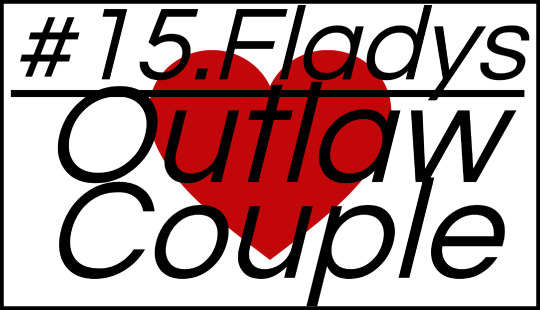


Outlaw Couple
Two lovers who team up to commit crime, usually violent crime and especially robbery, and are usually on the run from the law. Such couples are almost always inspired by Bonnie Parker and Clyde Barrow, "Bonnie & Clyde." Which one is the brains of the outfit tends to vary from couple to couple. Sometimes one is a calm and collected criminal who charms the other into a life of crime. Other times, one is a loose cannon while the other is a cool-headed professional. Many Bonnie and Clyde stories end in tragedy, as did the original couple. This one is Truth in Television, though it should be noted that most fiction tends to romanticize the life of crime that such characters tend to lead. Compare/contrast Minion Shipping. See Unholy Matrimony for a more over-the-top, super powered version of this team-up. Expect some Back-to-Back Badasses moments, as well as a selfish suicide if one partner dies. May result in sympathetic villains or even Sympathetic Murderers, especially if their affection for each other is given the spotlight.
#14. Hiramione (Hiram Lodge & Hermione Lodge; ROMANTIC TROPE: UNHOLY MATRIMONY)



Unholy Matrimony
Poison Ivy: Once you have frozen mankind, these babies will overrun the globe, and we shall rule them, for we will be the only two people left in the world. Mr. Freeze: Adam and Evil.—Batman & Robin
You know how the story goes, right? Big Bad meets Baroness, Baroness meets Big Bad, their eyes meet, and horribly discordant music that sounds not unlike the screaming of tortured souls arise. It's black magic... a match made in hell! Lord Worldbreaker and Lady Firestorm are, individually, serious threats to the heroes, but what happens if they're suddenly working intimately together? That's when it gets really dangerous. A pair of villains capable of channeling The Power of Love is enough to give even the most hardened group of heroes a serious challenge, and worse yet, seeing the villains in love may make them doubt their own motivations. Should one of the villains fall, the other one grieving over their fallen lover is quite likely to initialize an Alas, Poor Villainscenario, and maybe even a My God, What Have I Done? Should another villain start messing with the happy couple, it's usually played as a Kick the Dog moment. ...of course, these people are villains, so you can never really be sure that one or both of them isn't just playing at being in love, in order to manipulate and use the other. If the love is genuine but unrequited, expect the one who genuinely loves to sacrifice their life to protect the other, only for the other to disdainfully ignore them as they lie dying, proclaiming that they're no longer useful. Usually, this signals a crossing of the Moral Event Horizon. If both were faking it, expect them to show their true colors at the same time. Hilarity Ensues—and it's never mentioned ever again. The most classic version of this trope occurs when two previously established antagonists suddenly take a new-found interest in each other, but it can also involve a newcomer falling for an established villain, or even a pair of villains who were, from the beginning, a "villainous couple". In the first-mentioned scenario, Enemy Mine may occur in order to match the united power of the couple — which can get particularly interesting if the "bedfellow" is another villain, who is driven by jealousy...May form a Big Bad Duumvirate. Compare Villainous Friendship, when the two are truly friends with each other, but not in a romantic way. Contrast Minion Shipping (which involves minions instead of actual villains) and Mad Love (which is one-sided). Outlaw Couple is the petty crime version of this. In the case of fiction with multiple villains where taking two out of the equation would still leave a bunch of bad guys, if it's genuine on both sides this can be used as a prelude to a Heel–Face Turn or at the very least a "Get out of Jail Free" Card. If the couple in question is heterosexual, expect the man to be the more important half of the couple, possibly making her more of a Dark Mistress. Subtrope of Even Evil Has Loved Ones. Not to be confused with Awful Wedded Life, which describes the marriage itself to be terrible, not the people involved.
#13. Formione (FP Jones & Hermione Lodge; ROMANTIC TROPE: WELL, EXCUSE ME, PRINCESS! & FOE ROMANCE SUBTEXT)



Well, Excuse Me, Princess!
"Why must everything you say to me sound like a criticism?"— Robin Hood to Marian (BBC's Robin Hood)
Snarky loser hero meets snarky haughty heroine. They either fall in love, or they snark. Usually both. This is essentially a satire of the standard Magical Girlfriend, which describes a beautiful, classy, good-mannered, loyal girl—the logical result being she should be somewhat critical of her loser boyfriend. She makes no attempt to ignore the fact that he is the Loser Protagonist, and frequently calls him on it, criticizes him, and rarely if ever fawns over him like some Fangirl. She expects better from him and pushes him to improve, while still expecting to be taken care of. However, the guy usually takes it in stride, mocks her in return, or just says the trope title. Expect a generous helping of Aww, Look! They Really Do Love Each Other moments, to let the audience know why they should be supporting this couple. The idea is that the snarky loser will help the princess loosen up and be friendlier, while the princess constantly holding the loser to a higher standard will eventually make him improve himself. Often appears in Love Comedies, depending on how satirical the story is. See also Tsundere. Related to Belligerent Sexual Tension. Compare/Contrast Screw You, Elves! and Surrounded by Idiots. If it involves an actual Princess Princess, see Royal Brat. The Woman Wearing the Queenly Mask can make similar demands.
Foe Romance Subtext
"Thou hast beat me out Twelve several times, and I have nightly since Dreamt of encounters 'twixt thyself and me; We have been down together in my sleep, Unbuckling helms, fisting each other's throat, And waked half dead with nothing."— Aufidius to his blood enemy, Act 4, Scene 5, Coriolanus
The implications of sexual tension between arch-enemies. Just as Ho Yay is about the situation of implying romance where even the characters' canonical sexual orientations make it implausible, this trope intentionally creates an even deeper paradox by subtextually implying love in a relationship that is, textually, the opposite of love. This trope is much more likely to come into play if one is The Rival and The Only One Allowed to Defeat You, or a Rival Turned Evil, and is especially likely if one is an Evil Former Friend. If enemies have to work together, it can give the impression that adversity makes strange bedfellows. Other times, this trope can be invoked by a villain who seems to be too eager and persistent about trying to convince or force the hero to rule the world together, and eventually appear as a one-sided Villainous Crush. Terms of Endangerment often feature, and watch out for the "Take That!" Kiss. Dark Magical Girls are often depicted as understanding their Magical Girl counterpart far more than anyone else, and after inevitable redemption at the very least become Heterosexual Life-Partners, if not more. Since most heroes and their villains tend to be the same gender, this results in most examples of Foe Yay overlapping with Ho Yay, but different gender foes qualify too. When it ultimately goes from subtext to text, and the two admit that they love each other, it is called Dating Catwoman. Contrast with Defecting for Love. For the villain who really is sexually obsessed with The Hero, see Stalker with a Crush, Mind Game Ship, In Love with Your Carnage, and Villainous Crush. See also Destructo-Nookie, when they actually do go the whole nine yards. See also Foe Yay Shipping, for the subjective audience reaction of insisting that after a certain number of such scenes, the two should become a couple (this appeal often lies in the forbidden nature of the relationship, a staple of the shipper diet). Please move non-objective examples to that page. Not to be confused with Faux Yay.
#12. Fredmione (Fred Andrews & Hermione Lodge; ROMANTIC TROPE: RICH SUITOR, POOR SUITOR)
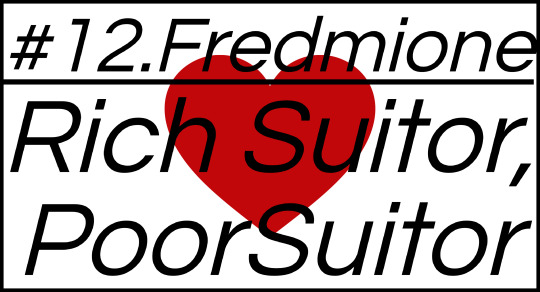


Rich Suitor, Poor Suitor
"One of them is dark and poor One fair with lots of money I don't know which one to choose The flower or the honey"—Celtic Woman ("At the Ceili")
One of the most common complications in the classic Love Triangle scenario. Two men are vying for a women's affection. Who's the right one? It's hard to tell, but there's a good chance that one of them is considerably wealthier than the other, and he can provide security, glamour and the good life, while the other (who has a good chance of being an impoverished artist) can give none of the same. What are you gonna do? Most of the time, it's going to be "go with the poor one," and the story will carry an Aesop that true love is worth more than material wealth. This makes sense if the rich one is a total bore or outright jackass, or the woman is just not in love with him as she is with the broke one. When done poorly, the rich one often ends up as the Designated Villain. This trope overlaps considerably with Wrong Guy First and Disposable Fiancé, but keep in mind that the rich suitor is not necessarily wrong, first or particularly disposable. This trope is most often "two men and one women" because of a sense that woman needs someone to 'provide for her'. This sort of logic ties into Unable to Support a Wife and generates part of this trope's conflict. If the suitors are also a Betty and Veronica pair, the dynamic will typically be either "poor but nice suitor vs. rich but haughty suitor" or "poor but exciting suitor vs. rich but boring suitor", being obviously slanted toward the poor suitor in both cases. In fact, having the rich suitor win or even be a decent, likeable person is a rare variation of this trope.note Perhaps the trope name should have been "Poor Suitor Wins" instead? The odd exception can happen though, with the rich suitor being a nice, decent person and the poor suitor being a male Gold Digger. Compare Gold Digger, Meal Ticket, and Uptown Girl. It can involve Compete for the Maiden's Hand.
End of Part I. Please check out Part II!
#varchie#jeronica#bughead#choni#falice#barchie#veggie#archosie#jarchie#beronica#cheronica#riverdale#gifs not mine
17 notes
·
View notes
Text
TLJ Review - Ship-free
I love TLJ. I did. I loved watching it, I loved being in the IMAX theatre, I loved watching my favorite people do some incredible things. So I’m gonna talk about it!! The good! The bad!! The Snoke face! All that good stuff. You know. Perhaps focusing more on character development than most other things this time around.
So let me just say, the opening scene??? Phenomenal. I love love love walking into a space battle! And it sets it up beautifully storywise, showing us Rose’s sister, and the sacrifices that were made to uphold Poe’s plan. And the great thing about this movie is that it shows both sides of the resistance. It shows that there are tons of people willing to sacrifice their lives to stop the First Order, and that a lot of the rebels are both willing sacrifices and downright reckless with their own lives, which is something we’ve all really come to appreciate about the Resistance. (Rogue One, anyone?) But it also shows us the price. Leia says it herself. They lost the entire fleet to take down that one destroyer, and while Poe clearly thinks that that’s worth it, Leia doesn’t think it is. Where you fall on this line is entirely up to the viewer, and I think that Lucas Films did a great job showing both sides.
Next we have Luke and his fortress of solitude. The Island was beautiful, the terrain amazing, all that good stuff. And I love the timing of the first scene where Rey hands Luke his lightsaber. There’s a lot of “oh my god this is it, this is it…” and then Luke tosses the damn thing over his shoulder and stomps away. I was like “Ah! There he is! There’s Luke!” in that moment, because this is him. He left his lightsaber and isolated himself, and what were we thinking? That he was just going to take it because some random girl brought it back to him? That’s not how people work, and I thought that was extremely realistic. They really committed to Luke’s character, and that his past in failing his new students really stuck with him. It made it even greater that he overcame it, because you could actually see what he was struggling with. I thought it made a ton of sense that Luke had shut himself off from the Force, because if he hadn’t, it would have been that much harder to turn himself away from the galaxy in the way that he did. (I promise I’m going to come back to Luke, okay. I have SO MUCH TO SAY about Luke).
Another thing I really enjoy about this movie is that it was unapologetic about showing when Poe was wrong. Poe is the perfect resistance hero character, he does what he wants despite the chain of command because he believes he is doing the right thing. It’s a trope we are all too familiar with when it comes to this sort of film, and still, we see that his choices led to consequences. He starts a mutiny, and then gets court martialed, essentially. Leia herself fucking shoots him, because he’s gotten so used to being a Commander and always having an ear in on the plan that not being let in messed with him, and I think it’s really nice that they show that he learns from that later. Because he orders everyone to turn back and then tries to get everyone out. It’s a really nicely done arc for him, in my opinion. It doesn’t sacrifice who we know Poe Dameron to be, instead enhancing it, in a way. Was the mutiny a little much? Yes. But I don’t think we’ve seen enough of Poe himself to really make a judgment call. It doesn’t seem like something TFA set him up for, but as a strand alone movie, I suppose it was okay.
Now, on to Rose. Rose is a new character, but what we learn about her is great. She is strong willed, and believes in this resistance to the point that she gives up her necklace to make sure that the code breaker helps them. It’s incredible of her to be able to do that, because she has so much faith in the Resistance and she knows it has to be done. They tell us where she’s from, and what she grew up doing, and then allow her to rectify this on that planet by freeing the animals there. She sums it up, in a moment of amazing clarity that “now, it was worth it.” because they freed something from the influence of the First Order. And that’s really what the Resistance is about, freeing anyone and everyone from the tyranny and just letting them be who they are meant to be. I also really really like that they let her be giddy. Usually when you have a smart tech woman on screen, she isn’t always allowed to geek out about things, and the entire first scene where Rose meets Finn is amazing. She speaks too fast, she asks too many questions, and STILL, still we see her put it together, and taze the man she just described as a hero. Because it was necessary. Because that’s what the Resistance is about. That’s what she believes is right. And she does it. She wasn’t about to let anyone make any stupid sacrifices, not after what happened to her sister, and that was that. I love Rose a lot.
Of course, and you knew I was going to say it, besides the little flail she has when she meets Finn, there is absolutely no build up for that kiss. None. Zip. Nada. And I appreciate the fact that they allowed Finn to make that expression during it and after, because THAT WAS THE SAME ONE ON MY FACE. Where did that come from???? No one freaking knows. Let two people of different gender who are next to each other for a long time be PLATONIC for the love of god. OR, and this is if you NEED the romance, like??? DEVELOP IT??? MAYBE??? MAYBE JUST A TINY BIT???? Kthanks.
Now for Finn. I love Finn. I love him a lot. His instinct to get the beacon off a doomed ship to keep Rey from returning it made sense to me as a continuation of his character. I know a lot of people have issue with how easily Rose was able to stop him from going, but I thought it made him seem more human. The same goes for their little mission going completely wrong. It was a far fetched, very Rogue-One esque plan, and honestly if it HAD succeeded, I don’t think the First Order would have any standing as a Big Bad. You know what I mean? Like, anyone can just code break onto a ship and make their way to mess with it? Just because the Empire had some shit security doesn’t mean that the First Order should. Especially since we saw that droid notice how oddly BB8 was moving when he was in that little box. I hope they learn to just like………… paint him. Next time. I found the fact that they failed a bit refreshing? Like. We’re all so used to everything going right for the good guys, and I like the idea of a struggle.
Did Finn need to be smacked across the face? No. That was too much. It didn’t need to be there.
I do, however, enjoy the change we can see from Finn, the guy who runs from danger, to Finn, the guy who flies his ship directly into a fucking drill to save the Resistance. It’s a good opposite to Poe’s story arc, I think, at least in this way. Poe becomes a less reckless, we-don’t-do-suicide-missions type of guy, and Finn turns into We-all-do-what-we-must-to-stop-the-First-Order type guy. It’s a good foil, executed in a pretty okay way. I would have LOVED for it to be set up better, but let’s be real, we gotta take what we get with this movie.
On to Rey. I think that her character in this movie was believable up to a point. Luke Skywalker, the myth, the dream, the legend, continuously shows her that he is not what she is expecting. He is not the man she thought he was, and so when Kylo tells her his version of things, and she can ACTIVELY FEEL that he is telling the truth, then of course she rages at him. Then, the reason she gets so upset, so deadset, on going after Kylo to try and turn him is because - as it is revealed later in the elevator scene,and then the snoke scene - SNOKE MADE THEM BOTH SEE WHAT THEY WANTED TO SEE. They had a vision of the future, and that was the future they desired. They both are lonely people who want someone to understand them, and this connection that Snoke brokered made them feel like they had something in common. Which is, of course, shattered when Snoke makes his reveal that it was all him. Then when they try and find that connection again, they can’t. They argue, they try and make the other see reason, they plead with each other, but the connection is gone. The only time they see each other again is when they’re actually in range of each other for the Force, and Rey sends a definite message. She closes the door on him. The connection is over. I thought it was pretty clear symbolism.
Bonus: Rey looking at Finn for a long moment to try and figure out who this new girl was to Finn. That expression. 10/10. It’s very clear that these guys have been apart for the entire movie, and I can’t wait to see them actually interacting on screen again, telling us how they feel, how their friendship has developed, I love it.
My favorite thing was the ending. Luke force projecting himself for that long was fucking epic. I love Luke Skywalker. He was so fucking badass. He was everything everyone expected, and more. He lived out his expectation of being a legend. Nothing could touch him. (CAN I JUST SAY!!! THE FUCKING “AIM EVERY GUN WE HAVE AT THAT MAN” and “DO YOU THINK YOU GOT HIM????” WAS FUCKING HILARIOUS). Then that lightsaber battle. Which wasn’t even really a battle, but. It was amazing. It made me remember how much I love Skywalkers.
I have a lot more to say on this movie but my memories awful so if ya’ll have questions feel free to hit that mf-in ask button
#tlj#review#tlj spoilers#the last jedi#star wars#finn#rey#kylo#rose#luke skywalker#no ship bias here folks#just good ole character development
5 notes
·
View notes
Text
Fictional Existence - Know Your Counterparts, Part 1: Chris McLean
Presenting more information on events taking place in Fictional Existence, where Hiatus Cafe takes place, each part focusing on a specific character and their known counterparts. (Now that my wisdom teeth are removed, I am getting back to concentrating on that line of fanfiction...!)
Chris McLean (08072007) - The Prime counterpart. Hosted the first five seasons of Total Drama until an inquiry about his murderous instincts (and previous criminal activities) forced him out of a job. His bosses have 'settled' the matter out of court, and he will be returning next year. Is officially gay, having married Chef during his years in unemployment, though debates about his Chris/plant hybrid 'son' continue to rage on. Whether the husbands' marriage will be referenced in the next season, in any shape or form, remains to be seen. Surprisingly has the same amount of fans on social media as those in the Real World.
“Chris McFat” (Coordinates yet to be catalogued) - A counterpart of Chris with Owen's body proportions. Despite his lack of exercise, he loves Chef's cooking due to having a cast-iron stomach from birth. While many viewers and critics have voiced their concerns over Chris' weight and the fact he has to get around the island(s) by carpooling with interns, Chris insists that because 'there's more of me to go round', there are some viewers who still love him.
“Chris McSmol” (Coordinates yet to be catalogued) - A shrunken counterpart of Chris. His vinyl-figure size prevented him from hosting Total Drama in this Dimension (that role went to Don), but the arrival of Youtube allowed him to gain the same viewing figures through vlogging about his condition and the adventures he gets up to with his guardian, Chef. However, two years ago he got kidnapped by a crazed fan called Topher, and had to escape and journey cross-country until he found Chef again. A film adaptation is set to be released in 2019.
Emperor (Soon to be God) Chris (07082007) - A giga-sized counterpart of Chris existing in 'Alter-Existence', an existence adjacent to Fictional Existence made up of the Dimensions ruled by evil counterparts of Dimension Heroes, and one that is constantly under war by giant men of varying heights. Grown to giant size by radiation from Camp Wawanakwa during the events of Total Drama Island, he began his reign of destruction upon the planet, until he managed to conquer it in 2009. However, he isn't entirely corrupt, for he has so far spared the lives of those he managed to lovestruck with his looks. Is still growing; as of the last report from Alter-Existence (June 2017), he has grown to such heights that his shadow covers up continents. He aspires to conquer his universe by the end of the decade.
“Chris McParallel” (04012008) - This counterpart is seen in versions of Total Drama where the winning contestants are different from those seen in the Prime universe. He has worked on providing different voiceover links on various satellite channels across Europe, Asia, and the United States. As such, this Chris is more multilingual than the Prime Chris. Managed to snag Tom Baker's autograph after voicing links for Disney XD in the UK, and also tried to defend the show there when it moved from one late night spot (11pm) to another (2am in the bloody morning!). As day turns to night, so too will international audiences see this counterpart of Chris in 2018... on Netflix.
“Chris McToony” (28102010) - One of the most hilarious downfalls for any counterpart of Chris McLean covered here or not, belongs to the one seen in the US-Skatoony Dimension. Though this Dimension, compared with its Prime counterpart, provided a better 'crossover ratio' than the Prime version led everyone to believe, it was just as humiliating towards those who lost the rounds as those who were eliminated in Total Drama. It was sweet catharsis for the contestants of Total Drama in this universe, then, when Chris managed to fail the FIRST ROUND of the show, and was catapulted into the Home for One Hit Wonders. Humiliated for weeks afterwards, Chris made a deal with his bosses, and got someone to sabotage the Dangergrid of Doom and 'persuade' the boss of Skatoony, Charles, to upgrade the show to the 21st century. It is perhaps this ruthless act of vengeance, some say, that led to Chris becoming the Prime Minister of Canada in 2015.
“Chris McCartoonnetwork” (04122008) - A special counterpart of Chris McLean that only exists in the CN Spiral, the special name given to the CN Multiverse due to its spring-like shape. This is due to the fact that he presented a recap of Total Drama Island that didn't exist in the Prime version (or at least was different to the one seen in the Prime version). After the PunchTime Incident nearly destroyed the Multiverse, Chris championed the idea of incorporating Real World events, shows, and Dimensions into the CN Spiral upon its regeneration, as well as working together with Johnny Test’s agents to help promote the boy's adventures to those watching events in the Multiverse. Project: CN Real, as it came to be called, was later uncovered as a plot for certain individuals in the CN Spiral (like Chris and Bling Bling Boy) to enter the Sitcom War waged at that time by the Nickelodeon and Disney Multiverses and win it. Chris managed to escape the fate of Johnny Test and the Porkbelly Dimension (being exterminated by Spider Daleks and Dark Dimension Cybermen), but lived a private life in shame. Some theorists believe that Chris' cameo at the end of the last Total Drama season to take place in the CN Multiverse portrays the decision he made (and its results) in a thousand words, and that it was symphony from his fans that led to him getting his job back earlier this year.
Votecaster (----2009; A yet-to-be catalogued universal stream in the Primax cluster) - In one version of the Great War played out between the Autobots and the Decepticons, the Ark and the Nemesis crash-landed in CN City years before the FusionFall War took place. Not only did both factions scan Earth-based vehicles and gadgets to assume new forms, but their robot modes (or 'Kungfubots' to the locals) also took on the guises of various citizens living there, due to the raw Toonergy (the life force that makes a cartoon character a cartoon character) in the atmosphere. Votecaster, a Decepticon whose function was 'Propagandist', took on the appearance of Chris McLean in his robot mode (and a Jeep in his vehicle mode), and waged war against the Autobots with his team mates Spike Vulcan (Duncan) and Acid Burn (Chef). Votecaster and his friends had many escapades on the new planet. Though Spike Vulcan and Acid Burn were destroyed during the battle in Autobot City, Votecaster survived and expressed his views on becoming the new Decepticon leader after Megatron's death on board Astrotrain (TOM), and later bore witness to the destruction of Starscream (DNAlien) and the appearance of Galvatron (whose Toonergy was absorbed by Unicron during his reformatting, looking like all of the known Galvatrons of the Primax cluster). Later, when Unicron (who had eaten Planet Fuse during his arrival to CN City and mutated a little bit as a result) arrived, Votecaster was one of the many Decepticons who fought back against the god, but was devoured for their efforts.
4 notes
·
View notes
Text
Prologue
It was the long kind of war – waged by weary travelers and alien invaders, both convinced that once all the shots had been fired that there would be something left that they could call theirs.
They weren't wrong.
That’s what Jun Yang thought to himself as he peered out of the large viewport on his ship, the Democracy. Beyond the viewport was a stunning view of the Zheng He system, bluish-white light from its young star shining brilliantly through dust clouds and remnants of asteroidal debris. The Nexus glistened in the foreground.
The Nexus had completed construction in 2828, ten years after its arrival in Heleus, and just nine years after the Arks had arrived. By 2831, the Nexus had achieved its goal of becoming the hub of a multi-system expansion into the Andromeda galaxy.
But it was not an easy first decade for the Initiative. Their first two years in the Heleus cluster were mired with missteps, mutiny, death, and an alien aggressor that nearly wiped out the Andromeda Initiative. The human Pathfinder, Scott Ryder, and the crew of the scout ship, Tempest, defeated the Archon, but that was hardly the end of the Initiative’s conflict with the kett.
The war raged for more than a decade. But it was a peculiar sort of war. The conflict with the kett kept a strange ebb and flow. At times their numbers seemed hopelessly depleted, and the fighting seemed at an end. Then, just before the last of their forces could be defeated, there would be a surge in kett activity in another part of the cluster.
This kept on for twelve years. And only now, did it finally seem like it was coming to an end for good. Or so Yang hoped.
“Director Yang,” said a cool, professional sounding female voice over the ship’s intercom. “Ms. T’Vessa has just come aboard, and she’ll be ready for you momentarily.”
Yang was pulled out of his thoughts, and instinctively glanced over his shoulder.
“Thank you,” said Yang. “Send her in whenever she’s ready.”
Yang was in his forties, bald, and had a stern jaw. He was predominantly Chinese, mixed with hints of European and Native American heritage. He was wearing a formal, but modern looking black and gray suit.
He stood stoic in front of the viewport, hands clasped behind his back.
Yang took over the position of Director for the Initiative in 2829, after Jarun Tann died of natural causes. His meteoric rise to power in Heleus took nearly everyone by surprise. Prior to his selection as Director, he had led the nation of Advent, spurring them to unprecedented growth on Eos, even surpassing the Initiative’s official colonization efforts in Prodromos.
He rose to prominence behind enormous public support, and was selected to the position of Director with few detractors among the Initiative population, but not without making a few political enemies in the Nexus leadership.
Now the weight of the Initiative’s future rested on him. The war with the kett was winding down, the colonies were beginning to thrive, and for the first time people were calling into question how much longer the Initiative – a private organization – should stay in power.
There were many who felt the Initiative had already stayed in control too long. Support was quickly growing among a movement calling for the Initiative to disband, or at least to relinquish executive type power to a cluster-wide, if not galaxy-wide, government.
It was a move Yang supported, in theory. Part of his popularity among the Initiative population in Heleus was garnered because he was vocal about the need for a central government. But his fervor for democracy as a political outsider met with the difficult pressures of being in a position of executive authority during a time of war. If he attempted to transition the Initiative out of power now, during war time, it could prove disastrous.
It had been three years since his appointment as Director. He faced criticism from both sides – those that felt he was attempting to sweep aside the Initiative in haste, and those that felt he was moving too slowly. He had a scant few political moves left.
Today he would be facing the latest round of questions from HNS reporter Keri T’Vessa, who had come aboard his private ship to discuss the future of the Initiative.
These sorts of long form, one-on-one interviews were rare, and therefore crucial to his efforts to maintain positive public opinion of the Initiative. A mistake could be costly, but a strong showing was invaluable. In something of a bold move, Yang insisted that the interview be aired live.
The doors to his cabin slid open behind him. Keri T’Vessa entered wordlessly.
At first, Yang didn’t greet her. He didn’t even turn around. His hands stayed clasped behind his back, and his gaze stayed fixed on Zheng He and the Nexus.
“Did you know that blue stars have a much shorter life span than red ones?” asked Yang.
He could hear her footsteps behind him as she approached the viewport. She walked across the mahogany wood floor in the center of the room, then stopped just short of the carpeted area on the viewing deck.
“Astronomy was never my strong suit in school,” said Keri. “But I think I might have heard that before, yes.”
Yang still didn’t face her.
“Blue stars are much brighter also,” he said. “They die faster, but they burn brighter.”
“One might say it’s fitting,” said Keri.
“One might,” said Yang.
There was a comfortable pause, and then Yang finally turned to face her. He gave a warm, easy smile and nodded courteously.
“Welcome, Ms. T’Vessa,” said Yang. “And thank you for coming.”
Keri was wearing a blue and white dress, long and fitted, formal and not unflattering to her figure. She smiled back at him, and returned the nod.
“Thank you for having me,” she said. “This is an incredible vessel.”
“Did they give you the tour?”
“Not yet, but I’d be happy to have a better look around.”
“We’ll see to it after our chat.”
Yang extended his arm out to his side, gesturing towards the sitting area in the center of the cabin.
The cabin was immaculate. Fine hardwood floors, plush carpets, marble-top credenzas, and finely upholstered furniture. In the center of the cabin, a finely woven rug was laid out over the hardwood, and two chairs were set facing each other at an angle.
They both walked towards the chairs.
“And the Democracy… that’s under, Colonial Affairs budget, is that right?” asked Keri.
“Are we on the record already, Ms. T’Vessa?” asked Yang.
“I’d like it to be.”
“Then I’ll happily say this vessel has been instrumental in the Nexus’s outreach efforts with the colonies, spending 287 days in the last calendar year on missions to foster a greater cooperative culture in Heleus, and advocating for a purposeful move to democracy throughout the cluster.”
“That might be a good topic to start with.”
They both took a seat. Keri tapped a data pad and a camera drone that she had set by the door sprung to life. It zipped across the room spryly, and then bobbed up and down before settling in one spot to hover in front of them.
A light on the front of the drone switched on.
“Are you ready to begin?” asked Keri.
Yang leaned back into his chair and nodded. “Please.”
Keri held up three fingers, then two, then one, in perfect cadence. A red light on the drone turned on.
“Hello and welcome to Reflections and Conversations,” said Keri in a warm, natural tone. “I’m Keri T’Vessa and I’m honored today to be joined by the Director of the Andromeda Initiative, Jun Yang, to discuss the current state of the kett conflict, and the future of the Initiative.”
“I’m glad we could do this,” said Yang. “It’s a pleasure to be with you.”
“The pleasure is all mine,” replied Keri. “Let’s jump right into things… we’re just a couple of months beyond the twelve year mark in the kett conflict, and reports are that kett troop density is at an all time low, in all systems – given that, how confident are you that we are finally seeing an end to this war?”
“We’re close,” said Yang. “I know… that, this has been a hard twelve years. Many sacrifices have been, and our enemy has shown a resiliency that no one could have anticipated. We were never meant to be an army, not trained for war, but despite that, against all odds, we have prevailed.”
“But have we prevailed?” Keri interjected. “Truly? How close are we?”
“We’re in the process now of rooting out the last remaining kett bases in key systems,” said Yang. “Of course I can’t discuss the details, but as we speak there are Pathfinder teams in the course of some key operations.”
“And what of the Pathfinder teams? You’ve expanded their reach beyond the original four teams. Are they adjusting well to playing the role of paramilitary squad, as well as explorers?”
Yang shook his head amicably. “They are not paramilitary.”
“But aren’t they?” Keri countered. “The sorts of operations–”
“The sorts of operations they are doing are not appropriately handled by anyone else in the Initiative. They are uniquely equipped to survey and respond to new territories, potentially compromised by hostile threats.”
“That sounds like boilerplate rhetoric.”
“That is is an accurate description of a nuanced mission, that is, in fact, unprecedented, not only in the history of the Initiative in Andromeda, but perhaps in the history of mankind. We have faced unique threats in Andromeda, and adapted unique solutions driven by multi-disciplinary personnel.”
“With most of the Heleus systems charted, and – as you describe it, the Kett War winding down – do you believe the Pathfinders will always have a place in the Initiative?”
“I believe they are heroes, in the truest sense of the word. They have become our paragons, the ones we needed most, at the time we needed them most. Andromeda, not just the Initiative, will rely on the talents of Pathfinders for a long time into the future.”
“It sounds like you’re cognizant of a time when the Initiative may no longer be shaping the future of Andromeda. That brings me to our next topic, a very important one in the minds of many of our viewers. When will it be time for the Initiative to step aside, and allow the formation of a galactic government?”
“That is the inevitable future for Andromeda, as I have always said. The Initiative has been, and currently still is, the best steward of our future in Heleus, and throughout the galaxy. But a long term solution will be build around the democratic process, and representative government.”
“We’re all well aware of your position, Director Yang, you stated it quite clearly as President of Advent and as you campaigned for the Initiative Director position. But it’s been three years since you’ve taken your post, and yet, here we are, still under the auspices of the Initiative.”
“And still at war, might I–”
“But you just said the war was over.”
“I said the war was ending.”
There was a brief pause, not tense, but certainly telling. Yang pressed his gaze, almost daring Keri to break the silence.
“And what will the process look like?” asked Keri. “Once the war is over.”
Yang interlocked his fingers in front of him, and looked down to pause pensively.
“I believe, the process must involve the colonies,” he said. “Any process of establishing a government in Heleus will need the leaders who have already succeeded in the efforts of local government here.”
“You’ve said that before, Director, but you’ve never given any specifics. Please, elaborate on what you mean. How precisely will the colonial leaders be involved?”
“These things do require time to evolve naturally, and they require careful discussion with those involved. Laying out details here would be imprudent–”
“I’m not asking for you to commit yourself, but in a general sense, what sort of proceedings do you foresee?”
“Well, in a general sense, I think that a convention to draft a constitution would be a proper foundation. And a great start to that process would be inviting the colonial leaders, or their duly appointed representatives, to participate on a rules committee for the convention, so they have say-so in the formal process that will be used to determine our constitutional framework.”
“I’m sure many people in the colonies will be very glad to hear that.”
Yang nodded slightly, and barely gave the hint of a smile. The exchange hadn’t been unfavorable for him so far, but Keri T’Vessa was talented.
It was obvious the opening topic would center around the war, but she was wise to immediately follow it with questions about the formation of a government and the Initiative relinquishing authority. One of the primary pro-Initiative arguments was the need for stability during the war, even Yang had used it frequently. But following answers he’d just given about how well the war was going, this argument would either come off less convincing or two-faced.
He technically gave the correct answers, stressing the fact that the war was ending, but not yet over. And he left no room for doubt that Andromeda would have a democratically elected government. But she had still constructed the contrast she wanted.
The brief diversion onto the topic of the Pathfinders was unexpected. She seized on it only because he mentioned it; in some sense, it was smart of her, since the increasing militarization of the Pathfinder teams had become mildly controversial. But she cast herself into the role of antagonist when it came to the galaxy’s most prominent heroes, not an easy position to argue from. It was tricky to maintain the necessary divisions between ambassador-explorers and special forces troops, but in reality that distance could be entirely rhetorical. He insisted on their heroism, and gave the technically accurate sterile descriptions of their contradictory roles – enough to stifle most dissension about their increasingly military focus.
On the matter of how he would make good on his promise to ‘include the colonies’ in the formation of a central government, Keri was most skillful. Yang hadn’t meant to reveal any particular plans, and while he only spoke in vague terms to what was already assumed anyway, it would give the colonies added leverage in negotiating details, since his public commitment to having them on the convention rules committee would mean he couldn’t back off from that offer. It would, however, gain him even more public popularity, as it showed him as being open to local government involvement. This would place pressure on the colonial leaders to work with him, or he could cast them as the ones being difficult, and potentially threaten their re-election chances.
Yang admired Keri’s tenacity, and her sharp line of questioning. She was no push over. And that’s precisely what he needed. No matter how hard she pushed him, he would never do worse than batting .500, and that would also add to his credibility. He would have taken on a live, long form interview, without receiving any topics or questions in advance, opposite a seasoned and respected investigative journalist. It would only further serve his reputation of being honest and transparent. No matter what, Keri would serve his purposes just by doing the interview.
–
It was an hour and fifteen minutes later before they reached their final topic for the evening. Yang still had an easy, subtle smile on his lips, hands clasped together comfortably in front of him.
Keri showed only the slightest signs of fatigue, but the extended bout of rhetorical tactics hadn’t been easy.
“So, Director Yang, let me close on a very important topic,” she said. “The majority of Heleus systems have been charted. Although there is still much exploring to do on many planets, some have begun to ask, ‘what’s next?’ In the Milky Way, society expanded throughout the galaxy. And yet, in more than a decade in Andromeda, we’re confined to only one cluster.”
Yang knew this topic would come up. It was a savvy move on her part to save it for last.
He nodded his appreciation for her question. “Exploration is why we came here.”
He purposefully kept his reply brief, letting silence build to punctuate his next remarks. Keri eyed him carefully, being sure to keep quiet so he would keep talking. But Yang always intended to keep talking, this was a point he had had well rehearsed in his mind.
“There is something, within the human spirit, that yearns for exploration,” he said, carefully, deliberately. “There’s something deep within us that needs to make meaning from chaos, shine light into darkness, venture past what is known, and reveal truth behind mysteries. It is our destiny. I assure you, I assure all the people of Andromeda, that the Pathfinders will lead us beyond the Heleus cluster. Today, we have many challenges, here, in Heleus. We can say with pride, that this is our home. It has not been easy to earn the right to call this place home, and much work is still ahead of us. But the expansion of the Pathfinder team, our construction of new state-of-art scout ships and retrofitting of original Initiative scout ships, shows our strong commitment to exploration. We came here to explore Andromeda, all of it – and that’s exactly what we’re going to do.”
#mass effect#mass effect andromeda#fanfiction#writing#story#scifi#science fiction#scott ryder#odyssey to mayal ii
0 notes
Text
ADVERTISEMENT
Angelica May De Torres
There are plenty of commercials that have struck me, but one that I would like to share is that of a feminine hygiene company. Despite not showing the actual product on screen, the team was able to present what they can provide along with an inspirational message. The "Always #LikeAGirl" commercial is an inspirational advertisement that may appeal, inspire, and encourage women to avail their products.
Always, a company which provides feminine hygiene products, portrayed their product through a one-on-one interview with several girls and a boy. The main question that revolved in the video was, "How does a girl...?" in which half of them responded by acting frail. On the other hand, several of then showed strong movements as opposed to the others. Given this information, it is evident that the cause of the promotion is to appeal to women who struggle with the expectations of society. To influence people for longterm effects in terms of way of living and thinking, as a trend, the commercial tries to tell the audience that being, "like a girl," does not have to connect with negative connotations. Moreover, aside from advocating a message, they effectively presented their product by showing women that they are capable of doing physical activities without the worry of period leakage and the like.
Without showing a product, Always, presents their company and what they can offer through an effective advert. In hopes of starting a trend, they have much to offer to change the society's views on women. Along with their message, that may motivate and appeal to their audience, they may also appease the need for feminine care products.
Mheanne S. Ondoy
As a student that having a lot of things to do, I usually don’t have enough time to watch TV every day. I only got chance to watch TV on weekends at night since it is my free time with my family and then I accidentally watch the advertisement of Jollibee which really caught my attention since it’s about the sequel of the first part of the video released by the Jollibee where in it is all about love at first sight in Jollibee and I taught that they will be together but then the guy ended up as the best man in the weeding of the he loved. And then Jollibee released more videos about the love of the son to his mother, best friends met in Jollibee and love to someone which are based on a true story which caught my attention. I think the basic reason of the promotion is to showcase the real meaning of their tag line “Sa Jollibee, Bida ang Saya” wherein when you go to the aforementioned fast food chain you be happy when you eat there and they use true stories of other people as a weapon to strengthen their product. The target is to show how Jollibee could change someone life. For instance, they met in Jollibee, eat there and know someone that could change their life in a certain way. I think, the target of the advertisement are all Filipinos, one genre but different aspects of love, love to someone, to family, friends and other people. It conveys its message in a way that the videos catch the emotional facets of the clients and inspired by the videos that could reason for them to go to Jollibee and eat there hoping that they could also experience the same way and the same feeling when they go to Jollibee. I think the promoted product is a trend since Jollibee is existing long time ago and still in the market today and lot of people and still exist in the future with the help of the creative advertisement they are releasing.
Vanessa Antonette H. Mercado
From all the advertisement I’ve encountered Xbox advert life is short, even though the advertisement has been banned. It begins in a delivery room, where a screaming mom is delivering a screaming baby. The baby literally rockets out of her body and through a window, still screaming. The baby is shown hurtling through the stratosphere at a terrific speed. As it zooms across the skies, it slowly transforms into a little boy. Soon he begins screaming again, eyes wide with fear, as he arcs across the skies. He continues to age—into a young man, an adult. (He's still naked, so his hands find their way to a television-friendly position.) He screams and screams. He loses his hair; wrinkles develop, and his teeth yellow. He's old. His scream fades to a croaking groan. Finally, he slams into a grave in a leaf-strewn cemetery. The image dissolves to black and the following words appear in sequence: "Life Is Short." "Play More." "Xbox.". It caught my attention because it has a lesson not just about playing Xbox but people should appreciate life, live happily because we only live once and cherish every moment they have in their life because we don’t know when we will die, and another reason why it caught my attention is because at first when you watch it you can’t recognize what does the ad is promoting so the viewers really need to watch until the to know what was it all about. The underlying cause of the promotion is to play Xbox before you die and the ad convey about to be positive statement about life. It targets the people that is still alive to use and play Xbox before the day comes that you can’t play it anymore. Target clients has positive and negative comments about it, some says it is that the context it considered that the final scene of a body smashing into its grave was unnecessary and had caused considerable distress to many viewers, and some says it’s cool for having a baby boy that his entire life raging 9 months to 65 years old has been shown while screaming and it has a life lesson when a viewer see it in a positive way and has a deeper meaning. The promoted product is just a fad because it didn’t affect the life of the viewers and it just talked about by the people in just a short period of time.
Kyle Danes Navarro
From all the advertisement that I’ve encountered, the TV commercial aired at Japan was the one that caught my attention the most. Looking at the root of it, it promotes a product which is a Chocolate and of course, it targets the people who adore sweets. To convey its message to target clients, the commercial ad shows a woman who was trying to beat a world record by not blinking and the only thing that made her do such thing was just a bite from the advertised product. The main message of the ad was trying to tell how “good” the product tastes. I could say that the promoted product Is a fad.
Reyes, Ma. Katherine Grace B.
From all of the advertisements that I’ve encountered, I can truthfully only remember one. It’s Liza Soberano’s advertisement representing Domino’s pizza, and the reason why I remember it more than any of the advertisements that I’ve encountered is that I always happen to pass by it whenever I go back to my place or whenever I do go out. I mean how can I miss it? It’s as big as a gate!
I know, there’s nothing really that significant about the ad, but I happen to like pizza. A lot. It’s kind of difficult to ignore since it’s talking about a promo for pizza. Targeting all of the financially and not so financially stable people; in short, everyone. I have no idea if it could be considered a trend or a fad, but I guess it isn’t? Dominos isn’t exactly a thing to be a trend or fad yet I suppose; since all people ever think about these days are getting thin and healthy, because it’s you know, a trend. Anyway, I only ever think about food and books, so I don’t really know any advertisements that has a product with the potential to be a trend.
Diether Malabanan
The best advertisement that caught my attention is from the commercial TIDE, it is a bar and a cleansing powder necessary for clothes. Moreover, the advertisement for me is attractive since it is entertaining and catchy particularly in the part wherein the person gets his clothes whiten up after a tide bar slides through him. In addition, Tide promotes their product that intends to have credibility, quality and can be trustworthy. All of the people is their target to use their product, they use an entertaining commercial with some catchy phrases to their clientele for the product to be encouraging. However, despite of its creative nature it is a fad since the product is not used by the youth who are the fundamental user of media.
Pauline Villafuerte
A commercial becomes memorable when there is simplicity and clarity in the presentation, whether the approach is humorous, dramatic or slice of life. And for me, the most remarkable among all the commercials that I have seen was the FITA commercial. Seated on a bench at the park, a young man is about to take his last two pieces of Fita. From his left, a girl beats him to it and grabs it. He is left with the last piece but an old lady comes near him and wants it. He is hesitant at first, but on the latter part, he breaks the biscuit into two. Then, the lady turns into a beautiful fairy and rewards him with a wish. He answered, “sports car.” He gets it, an actual sports car cut in half, loudly dropping from the sky.
In a world full of constant changes, we, humans tend to be selfish and half-hearted to the good deeds that we are doing. What the commercial is trying to portray is the value of giving wherein you wouldn’t doubt your first instinct which is to give what you have to the one who is really in need without expecting a reward. The fita commercial is addressing the problem that is somehow, prevalent in our society and promotes the notion of “share your blessings” in a humorous and witty that definitely catch the eyes of the audience and wins the hearts of the Filipinos.
Overall, the fita biscuit is considered a trend because it’s not merely part of a moment, it’s a tool, a connector that will become more valuable as other people see it. This biscuit had been part of the barkada bonding, daily snacks and merriendas and sharing of a lot of people. Furthermore, the commercial does not only promote the value of sharing but also, it reiterates the value of camaraderie and kindness which is vital in achieving a progressive and equal society.
Ramos, Karla Michelle A.
Do you believe in second chances? This is the question that you would not have just done it before and appreciate the things that are still on you and you will not let them disappear.
The advertisement that caught my eyes and the eyes of the crowd that penetrate into everyone’s heart is the best sequel of McDonalds, because the concept itself is relatable for everyone. McDonald’s presents a sequel; this advertisement told a story from a different perspective. The characters behind the product are the one who brings out the taste of the feeling of being broken, alone, and the feeling they have left the one you love in life in just one snap and they also added the exciting twist. But what happened to the couple who got broken up already is right after that, the other day, they saw each other again in the same place where they have broken up the relationship they have lost. The girl smiled at his ex-boyfriend, but after she smiled at him, his ex-boyfriend was shocked by what he saw, the thing that he never gives up before, wishing her to get back to him again and realizing that he left the girl who love him so much but it will not happen again because he saw his ex-girlfriend with the guy who is willing to make her smile and will take care of her every day. And he sighed and sat down after he saw them happily together and said to himself that if “she can move on, so I can,” also he ate his burger and leave a smile on his face.
The character shows an unforgettable and heart-breaking scene to the commercial, they want to emphasize the feeling that someone you love, left you and everything is changing, you will realize that not everything will stay in a way you wanted and not everything will leave you without a reason. Moreover, the advertisement takes us to the world that we will always go back in the place where we started. They want to offer us one of their delicacy that will bring us the courage to stand up and forget everything that should not be thought out anymore and start a new one with no doubt, prove that you can be better enough for someone. Through that, you will experience the feeling of being better and how different you are now. It’s just like a burger, if you want to be better for anyone, try to be different and be an extraordinary, it will lead to a delightful taste that everyone will love the heavenly feeling of it. Additionally, they want to get more attention of people by thinking of a sequel critically that can relate it to nowadays couple. To give them a lesson learned in every mistake they did before and start over again and to those people who are giving up to their life, learn to wait and just don’t give up even though it is hard or easy to find an answer in every problem you are facing now just close your eyes and take a deep breath and believe that there are reason and purpose why are these happening in you. Try to smile and fight your problems by solving it in your own, find a way that you can be motivated again and continue what you have started.
The video became a hit on social media, they have got more attention from the crowd because of the sequel and right choice of music it fits in the concept they have made in the advertisement, but also it was an emotional scene that can affect us in a long run. According to Christina Lao, McDonald’s Philippines Marketing Director, the quick-service restaurant chain thought it would be interesting to see the point of view of Tony, the ex. “We wanted to do it in a simple but engaging way. The new video shows another day at McDonald’s, plays the song from the boy’s point of view, and shows 3 characters together — the story will write itself from there,”. Furthermore, Lao explains that McDonald’s continually tries to find different ways to tell stories as “flipping sides makes people realize that everything is never as it seems.” By teaching us if she can move on and be happy, so can you. Though it is an example of fad, it will remain as the best food advertisement for me because of how they delivered it well and make an impact that can surely caught an attention of the people. Second chances are not given to make things right. But are given to prove that we could be better enough, even after we fall. When change happens, it can be for the better. A welcome change with the new Burger McDo from McDonald’s.
Kristine Reyes
As our generation increasingly inclines to modernized technologies such as computer, cable television and mobile phones, the business world flexed the horizons of their capacity by campaigning their products and services on the modern world. Due to this, I’ve watched and encountered various TV commercials and advertisements everywhere – be it on the television, radio and online sites. But despite viewing many commercials, there is only one advertisement that caught my attention. That is the 2016 Jollibee commercial entitled “Kahera”. This video is based on a true to life story of a Jollibee cashier who always serve this strict and snob old lady every day. Even her crooked nameplate and wrong pronunciation did not escape on the old lady’s meticulousness and scrutiny. Thus, she received constructive but stern feedback from this elderly regular customer. Later on, it was revealed that this old lady is the cashier’s grandmother supporting her granddaughter to achieve high positions by disciplining her in work. The grandmother keeps a tight watch to her granddaughter to ensure that the latter is groomed to do her job well and succeed.
The promotion was made to celebrate the Grandparents day. Moreover, this is part of the holistic campaign of the organization that aspires to honor and support our beloved grandparents in return especially those who continue to work despite their growing weaknesses. It targets all the granddaughters and grandsons who received the never-ending love and support of their grandparents. With this, it is necessary to reciprocate all their love, support and even their sacrifices even if it is just by honoring them on their special occasion. Since it is believed that Filipinos exhibit close family ties, almost all Filipinos have been touched by this story.
By showing the efforts our grandparents can give to us even in a harsh yet productive way, the advertisement was able to convey their message to the target audience. By this, we can infer that our grandparents can support us in every way possible even if it is not sugar-coated. Their care and provision will always be pure and wholesome that will lead us to our own betterment and success.
Jollibee Group Foundation was very creative and innovative in sharing a touching story of their own staff in advertising their products and promoting the special occasion. This led their products to trend in the market. The aforementioned company is popularly known as the Philippines’ number one fast-food brand that also steps up in the worldwide businesses. All Filipinos in all over the world crave for Jollibee products. Not only that, even foreigners advertise and ask for this fast food chain to establish their chain in their countries. Until now, Jollibee has still this large impact to the taste expectations of people. In a single city, for example, here in Lipa, multiple Jollibee stores are located and still, they reach the minimum profit enough to sustain their own stores. Surely, this business gains a lot of money but to help their fellow Filipinos in return, they provide scholarship and various programs to support underprivileged. This is another evidence that the Jollibee products are trends and not only fads. Some of these programs are Tree-Planting and Nurturing Programs, Water Management and Conservation, Waste Management, Energy Management Conservation, College and Technical Training Scholarship such as Project ACE Scholarship, Jollibee-Gawad Kalinga Villages and the Joint Program of Jollibee and KALASAG farmers. Through these programs supported by the trending products of Jollibee, sustainability can be achieved as these projects support the community through taking care of the environment and its people.
Denise Angelika Sta. Maria
The current advertisement of Globe, the Gosurf50 promo that has data for playing Mobile Legends. It was an eye-catching for a player of Mobile Legends like me because it gives me the opportunity to play my favorite game even when I’m in outdoor places.
The increase of players of Mobile Legends is the underlying cause of such promotion and serves as the target of the advertisement. And to make the advertisement appealing, they took some essential audios and images from the game so that whenever it is being advertise, most of the players focus on it and this is the perfect timing to endorse their ‘solution’ for those who wants to play it more often whether they are at indoors or outdoors.
It is considered as a fad because the game is only for a short period of time and this is where the promotion depends on. If it decreases in popularity, such promotion will surely fade away.
Jessica Marie O. Mora
Pond’s is a well-known brand for face regime around the world which at first only targets teenagers and women but a few years later, also launch product for men. The beauty company (Pond’s) throughout the years, has develops variety of product ranging from facial foams to facial cream with different active ingredients in order to solve facial problems such as pimple, wrinkles and dark spot.
Every then and now, we can admit that we are very conscious about how we look-from head… to toe- most especially, when it comes to our faces. We all hate having pimples that suddenly pops up in a very acceptable place. To solve this problem, Pond’s Acne Clear Facial Foam is for us to try for. This facial product is especially made for acne-prone skin type. At the start of the commercial, Julia Baretto, say things that we girls, for many years, do just to hide the embarrassing pimple through cover. Which is true and this product will bring us hope. According to the commercial, by using this product, in just 3 days’ pimples will be lose, which is good news for a teenager like me. it has lock clear technology that can help to remove the pimple-causing bacterial. Hence, we will never be embarrassing again to meet people in person without covering anything.
A lot of girls around the world try this and give a good review about the product. Not just because of the commercial information, it is a proven effectively and dermatologist tested safe. Moreover, this product is worth buying for not just because it is effective but it is very affordable for everyone. Thus, it can be a consider as a trend since this product has been proven affective for a long time and has swayed it viewer of its effectiveness to remove and lessen the pimple. Nevertheless, its effectiveness still varies to each person and also the use of other product accompaniment.
0 notes